Motorola Mobility T56KD1 i680 PORTABLE iDEN/MOTOTALK MOBILE WITH BLUETOOTH User Manual Exhibit 12
Motorola Mobility LLC i680 PORTABLE iDEN/MOTOTALK MOBILE WITH BLUETOOTH Exhibit 12
Users Manual

FCC Filing Package for Motorola i680 Transceiver FCC ID: IHDT56KD1
iDEN, Motorola Inc., 600 North US Hwy 45, Libertyville, IL 60048, USA WWW.MOT.COM/iDEN
Exhibit 8: Draft User’s Manual -- 47 CFR 2.1033(b)(3)
The attached User’s Manual is a draft version, but sufficiently captures the essentials of device
operation. Selected portions of the User Guide can be found as indicated below:
8.1 Part 15B Declaration of Conformity: Page 4
8.2 Safety Section: Page 109
8.3 Specific Absorption Rate (SAR) Data: Page 107
8.4 Guidance for use with Hearing Aids: Page 49, 122

User’s Guide
i680

DECLARATION OF CONFORMITY
Per FCC CFR 47 Part 2 Section 2.1077(a)
Responsible Party Name: Motorola, Inc.
Address: 8000 West Sunrise Boulevard
Plantation, FL 33322 USA
Phone Number: 1 (800) 453-0920
Hereby declares that the product:
Product Name: i680
Model Number: H85XAH6JR5AN
FCC-ID: IHDT56KD1
Conforms to the following regulations:
FCC Part 15, subpart B, section 15.107(a), 15.107(d) and section 15.109(a)
FCC Notice to Users
The following statement applies to all products that have
received FCC approval. Applicable products bear the FCC logo,
and/or an FCC ID in the format FCC-ID: IHDT56KD1 on the product
label.
Motorola has not approved any changes or modifications to this device by
the user. Any changes or modifications could void the user’s authority to
operate the equipment. See 47 CFR Sec. 15.21.
Class B Digital Device
As a personal computer peripheral, this device complies with part 15 of
the FCC Rules. Operation is subject to the following two conditions: (1)
This device may not cause harmful interference, and (2) this device must
accept any interference received, including interference that may cause
undesired operation. See 47 CFR Sec. 15.19 (3).
Note:
This equipment has been tested and found to comply with the limits for
a Class B digital device, pursuant to part 15 of the FCC Rules. These limits are
designed to provide reasonable protection against harmful interference in a
residential installation. This equipment generates, uses and can radiate radio
frequency energy and, if not installed and used in accordance with the
instructions, may cause harmful interference to radio communications.
However, there is no guarantee that interference will not occur in a particular
installation.
If this equipment does cause harmful interference to radio or television
reception, which can be determined by turning the equipment off and on,
the user is encouraged to try to correct the interference by one or more of
the following measures:
•
Reorient or relocate the receiving antenna.
•
Increase the separation between the equipment and receiver.
•
Connect the equipment into an outlet on a circuit different from
that to which the receiver is connected.
•
Consult the dealer or an experienced radio/TV technician for
help.
Industry Canada Notice to Users
Operation is subject to the following two conditions: (1) This device may
not cause interference and (2) This device must accept any interference,
including interference that may cause undesired operation of the device.
See RSS-GEN 7.1.5.

Motorola, Inc.
Consumer Advocacy Office
600 North US Highway 45
Libertyville, IL 60048
www.hellomoto.com
Note:
Do not ship your phone to the above address. If you need to
return your phone for repairs, replacement, or warranty service,
please contact the Motorola Customer Support Center at:
1-800-453-0920 (United States)
1-877-483-2840 (TTY/TDD United States for hearing impaired)
Certain mobile phone features are dependent on the capabilities
and settings of your service provider’s network. Additionally,
certain features may not be activated by your service provider,
and/or the provider's network settings may limit the feature’s
functionality. Always contact your service provider about feature
availability and functionality. All features, functionality, and other
product specifications, as well as the information contained in this
user's guide are based upon the latest available information and
are believed to be accurate at the time of printing. Motorola
reserves the right to change or modify any information or
specifications without notice or obligation.
MOTOROLA and the Stylized M Logo are registered in the US
Patent & Trademark Office. All other product or service names are
the property of their respective owners. Java and all other
Java-based marks are trademarks or registered trademarks of Sun
Microsystems, Inc. in the U.S. and other countries.
© Motorola, Inc., 2009.
Manual Number: NNTN7797A

3
contents
contents
check it out . . . . . . . . . . . 2
menu map. . . . . . . . . . . . 6
use and care . . . . . . . . . . 8
essentials . . . . . . . . . . . . 9
about this guide . . . . . . 9
SIM card. . . . . . . . . . . 10
microSD card . . . . . . . 10
battery . . . . . . . . . . . . 12
turn it on & off . . . . . . 15
enable security . . . . . . 15
make a phone call. . . . 16
answer a phone call . . 16
advanced calling . . . . . 16
make a private call . . . 17
answer a private call. . 18
store a phone number
or private ID . . . . . . . . 19
contacts . . . . . . . . . . . 20
call a stored phone
number or private ID . 20
finding your phone
number and private ID 21
messaging . . . . . . . . . 21
MMS features . . . . . . 22
inbox. . . . . . . . . . . . . . 26
outbox . . . . . . . . . . . . 31
sent items . . . . . . . . . 31
customize messaging. 32
using your handset as
a modem . . . . . . . . . . 38
basics. . . . . . . . . . . . . . . 39
display . . . . . . . . . . . . 39
main menu . . . . . . . . . 40
carousel menu . . . . . . 40
text entry . . . . . . . . . . 41
volume . . . . . . . . . . . . 44
navigation key. . . . . . . 45
handsfree speaker . . . 45
transmitters . . . . . . . . 45
use GPS with map
software . . . . . . . . . . . 45
features for the
hearing impaired. . . . . 46
TTY . . . . . . . . . . . . . . . 47
security features. . . . . 48
main attractions . . . . . . 49
water resistance. . . . . 49
multimedia . . . . . . . . . 49
my music . . . . . . . . . . 54
my images . . . . . . . . . 62
my videos . . . . . . . . . . 63
camera . . . . . . . . . . . . 64
camcorder . . . . . . . . . 67
PTX features . . . . . . . . 69
4
contents
one touch PTT . . . . . . . 76
PT manager . . . . . . . . . 78
Bluetooth
®
. . . . . . . . . 79
call features . . . . . . . . . . 83
turn off a call alert . . . . 83
recent calls . . . . . . . . . 83
redial . . . . . . . . . . . . . . 84
caller ID . . . . . . . . . . . . 84
call forward . . . . . . . . . 85
voice names . . . . . . . . 85
emergency calls . . . . . 86
international calls. . . . . 87
speed dial . . . . . . . . . . 87
voicemail . . . . . . . . . . . 87
selective dynamic
group (SDG) calls. . . . . 88
MOTOtalk
TM
. . . . . . . . . . 92
switching to
MOTOtalk . . . . . . . . . . 93
exiting MOTOtalk. . . . . 93
channels and codes . . . 93
private MOTOtalk calls 96
making emergency
calls while in
MOTOtalk
TM
mode . . . 97
setup options. . . . . . . . 98
customize. . . . . . . . . . . 100
ring tones . . . . . . . . . 100
backlight . . . . . . . . . . 101
wallpaper . . . . . . . . . . 101
datebook . . . . . . . . . . 102
hide or show location
information . . . . . . . . 103
reorder apps menu . . 105
Legal and Safety . . . . . 106
Safety and General
Information . . . . . . . . 106
Operational
Precautions . . . . . . . . 107
RF Energy
Interference/
Compatibility . . . . . . . 107
Bluetooth. . . . . . . . . . 108
Caring for the
Environment by
Recycling . . . . . . . . . . 109
Driving Precautions . . 109
Operational Warnings 109
Open Source
Software Information. 111
Service and Repairs. . 112
Export Law
Assurances . . . . . . . . 112
Battery Use and
Safety . . . . . . . . . . . . 112
Battery Charging . . . . 114
Specific Absorption
Rate . . . . . . . . . . . . . . 114
AGPS and
Emergency Calls . . . . 115
Limited Warranty
Motorola
Communications
Products
(International). . . . . . . 116
5
contents
Hearing Aid
Compatibility With
Mobile Phones . . . . . . 119
Information From
the World Health
Organization . . . . . . . 120
Product Registration. 120
Wireless: The New
Recyclable . . . . . . . . 120
California Perchlorate
Label. . . . . . . . . . . . . 121
Patent and
Trademark
Information. . . . . . . . 121
Software Copyright
Notice. . . . . . . . . . . . 121
Privacy and Data
Security . . . . . . . . . . 122
Smart Practices
While Driving . . . . . . 122
index . . . . . . . . . . . . . . 124

6
menu map
main menu
B
Recent Calls
L
Contacts
• [New Contact]
• [New SDG List
E
Messages
• [Create Message]
•Voice Mail
• Inbox
•Drafts
• Outbox
• Sent Items
•Fax Mail
• Net Alert
1
Web
•Net
j
Multimedia
• Media Center
• My Images
• My Music
• My Videos
•Camera
• Camcorder
• Ring Tones
•VoiceRecord
S
Push To Talk
• Call Alert
• PT Manager
•Quick PTT
• PTT Options
•MOTOtalk
T
Games and Apps
•Buy More
• Alarm Clock Plus
• My Images
• My Music
• My Videos
• Java System
• Memory Card
C
To o l s
• My Info
•My Name
• Mobile
• Private1
• Private2
•Work1
•Work2
•Home
• Email1
• Email2
•Fax
• Pager
• Talkgroup
•IP
• Other
•IP1 Address
•IP2 Address
•Profiles
• [New Profile]
• Standard
•Car
• Meeting
•Office
• Outdoors
• Headset
•PRVT Only
•CNTCS Only
• Alarm Clock Plus
• Bluetooth
• Audio Devices
• Pair to Devices
• Device History
• Setup
• Find Me
• File Transfer Help
•GPS
• Position
• Privacy
•Interface
• Datebook
• [New Event]
• Call Timers
•Last Call
• Phone Reset
• Phone Lifetime
•Prvt/Grp Reset
• Prvt/Grp Lifetime
• Kbytes Reset
•Memo
u
Settings (see next page)
This is the standard main menu layout. Your
phone’s menu may be a little different.
7
settings menu
Display/Info
• Wallpaper
•[Buy More]
• Internal
• External
•Text Size
• Theme
• Backlight
•Timer
• Java Timer
•Clock
•Display
• Screen Saver
•Time Format
• Date Format
•Year
• Menu View
• Icon View
•List View
•Tab View
• Large Dialing
• Language
Phone Calls
• Set Line
•Any Key Ans
• Auto Redial
• Call Waiting
• Auto Ans
• Flip Activation
• Minute Beep
• Call Duration
• TTY
• Hearing Aid
• Notifications
• DTMF Dialing
• Call Forward
• Prepend
Personalize
• Reorder Menu
• Shortcuts
• Carousel
•Up Key
•Down Key
•Left Softkey
• Right Softkey
•Power Up
Vo l um e
• Ringers/Alerts
• Speaker
• Earpiece
• Multimedia
•Keypad
Voice Playback
• Speak Text
• Speak Caller
•Voice
• Multimedia Volume
Memory Card
• Remove Card
• Store Media
• Format Card
•Help
Security
• Phone Lock
• Keypad Lock
• SIM PIN
•GPS PIN
• Change Passwords
Advanced
• Alert Timeout
• Call Completion
• Headset/Spkr
• Connectivity
• Reset Defaults
• Return to Home
• Transmitters
• Phone Only
Connections
• Bluetooth
•USB
• Memory Card Access
•Data Modem
• Application Access
•GPS NMEA
•Help

8
use and care
Use and Care
To care for your Motorola phone, please keep it away from:
liquids
The i680 may be immersed in up to one
meter of water for no longer than 30
minutes when the battery door is
attached properly, and the headset jack
and micro-USB connector are properly
covered and sealed.
cleaning solutions
To clean your phone, use only a dry soft
cloth. Don’t use alcohol or other
cleaning solutions.
microwaves
Don’t try to dry your phone in a
microwave oven.

9
essentials
essentials
Caution:
Before using the phone for the first
time, read the Important Safety and Legal
information included in the gray-edged pages
at the back of this guide.
about this guide
This guide shows how to locate a menu
feature as follows:
Find it:
/
>
u
>
Phone Calls
This means that, from the home screen:
1
Press the menu key
/
and then press
the
Settings
menu option
u
.
2
Press the navigation keys
;
to scroll to
Phone Calls
, and press the center key
r
to
select it.
symbols
This means a feature is network or
subscription dependent and may
not be available in all areas, or might
not be offered by your service
provider. Contact customer service
for more information.
This means a feature requires an
optional accessory.
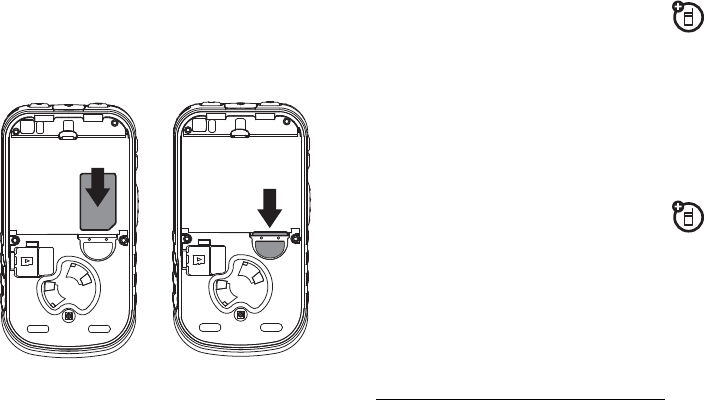
10
essentials
SIM card
insert the SIM card
Warning:
To avoid loss or damage, do not
remove your SIM card from your phone
unless absolutely necessary.
microSD card
Your handset may come with a microSD
card, microSD card adapter, and microSD card
reader
1
.
A microSD card is removable flash memory
you can use to store pictures, videos, and
audio files.
You can connect your phone using a
Motorola data cable directly to your
computer, access the microSD card
loaded in the phone to save or delete music,
images, videos, or audio files.
Find it:
/
>
u
>
Connections > USB
1. Depending on your service provider, the memory card,
memory card adapter, and memory card reader may not
be included with your phone. Your handset can be used
with a MicroSD memory card.
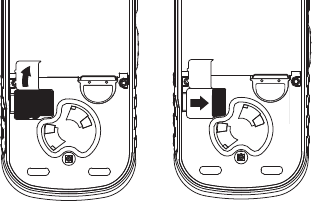
11
essentials
insert the microSD card
1
Remove the battery door, lift the black
plastic indicator and slide the microSD
card in place. Return the battery cover
when you are done.
Note:
The first time you insert a microSD card
in your phone, you will see the following
options:
[Do Nothing]
,
Go To Music Player
,
Go To Camera
,
and
Go To Media Center
. Select the option of your
choice and continue.
remove the microSD card
Warning:
Do not remove the microSD card
before selecting the
Remove Card
option under
Settings
. Removing the microSD card before
selecting the
Remove Card
option could result in
loss of data.
1
From the home screen press
/ >
u
>
Memory Card > Remove Card
.
2
Once the handset confirms it is safe to
remove the micorSD card, press
K
under
OK
.
3
Remove the battery door.
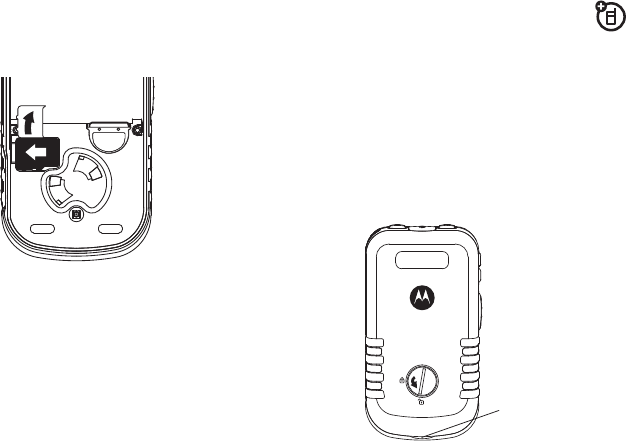
12
essentials
4
Lift the black plastic indicator and, with
your fingernail, slide the memory card out
of the slot.
5
Close the memory card slot cover.
battery
Note:
Please consult “Battery Use and
Safety” on page 112 before using this
product.
battery installation
1
With a coin, turn the battery door latch
to the unlocked position.
Note:
Do not use a sharp object as it may
damage the lock.
Finger Recess
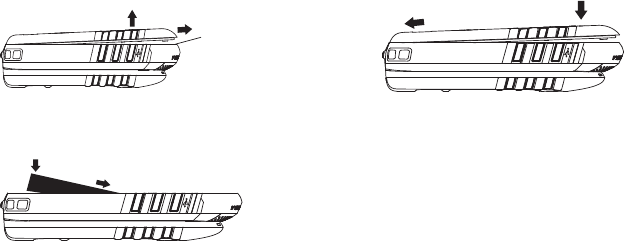
13
essentials
2
Place the tip of your finger in the finger
recess, and gently lift the battery door
to remove it from the phone.
3
Push the battery down until it snaps in
place.
Note:
You may proceed to attach a
lanyard (sold separately) on your phone.
Finger Recess
4
Replace the battery door and press
down on it gently. With a coin, turn the
battery door latch to the locked position.
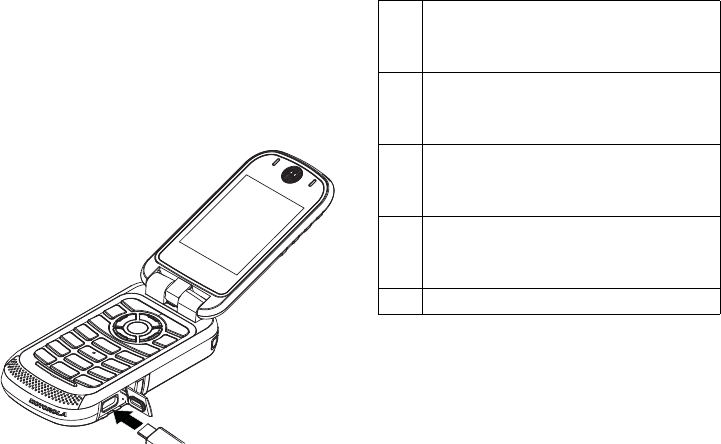
14
essentials
battery charging
New batteries are not fully charged.
charge using the charger
1
Pull out the connector cover, and insert
the charger into the micro USB connector
on your phone as shown.
battery indicators
d
The battery is at approximately 100%
to 90% capacity when the indicator is
blue and displaying three bars.
e
The battery is at approximately 65%
capacity when the indicator is green
and displaying two bars.
f
The battery is at approximately 10%
capacity when the indicator is yellow
and displaying one bar.
g
The battery is at approximately 5%
capacity when the indicator is red
and has a flashing red bar.
h
The battery is charging.
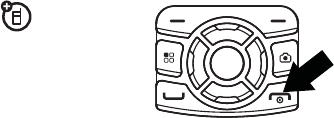
15
essentials
charge from your
computer
You can partially charge your phone’s battery
by connecting a Motorola-approved USB cable
from your phone’s micro-USB port to a high
power USB connector on a computer (not a
low-power one, such as the USB connector
on your keyboard or bus-powered USB hub).
Typically, USB high-power connectors are
located directly on your computer.
turn it on & off
To turn on your phone, press and hold
@
for
a few seconds or until the display turns on. If
prompted, enter your four-digit unlock code.
To turn off your phone, press and hold
@
for
two seconds.
Note:
If you press the
@
for more than four
seconds, the handset will power “On” in
Transmitters Off
mode. See “transmitters” on
page 45.
enable security
You must enable security the first time you
power on your phone or within 10 days of first
activation of your phone.
1
Press
K
under
Ok
.
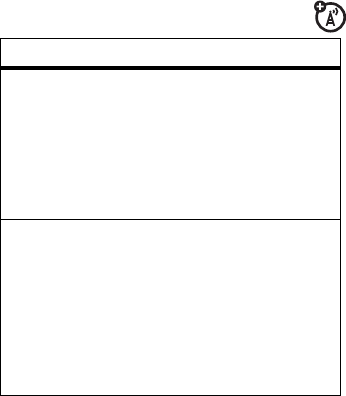
16
essentials
2
You are prompted to enable security.
Press
K
under
Yes
. A series of screens
followed by the default home page
displays.
3
Press
@
to return to the home screen.
make a phone call
Enter a phone number and press
`
or use a
voice command. See “place a call using a
voice name” on page 86.
To hang up press
@
.
answer a phone call
1
If you want to answer the call on speaker
phone, press the speaker key
)
.
2
If you want to answer the call using the
handset, press
`
. To hang up press
@
.
3
If you are using a Bluetooth headset,
press the answer key on your headset. To
hang up press the key again.
advanced calling
feature
call waiting
To accept the second call
and put the active call on
hold press
K
under
Yes
.
To accept the second call
and end the active call press
`
.
3-way call
Make or receive a phone call
and press
/
>
3 Way
. Enter
the second phone number,
press
`
and
K
under
Join
.
You cannot make any other
calls during a three-way call,
even if one party hangs up.

17
essentials
make a private call
Your Private ID is the number at which you
receive one-to-one Private calls.
Talkgroup numbers are numbers through
which you receive one-to-many group calls.
to make a Private call
1
Enter the Private ID you want to call.
2
Press and hold the PTT button. Begin
talking after your phone emits a chirping
sound.
3
Release the PTT button to listen.
To end the call press
@
.
Note:
A Private call ends automatically if there
is no activity on the call for a few seconds.
send call alerts
Sending a call alert discretely lets the
recipient know that you want to talk to him or
her on a Private call.
When you send a call alert, the recipient’s
handset displays your name and emits a
series of beeps or vibrations.
to send a call alert
1
Enter the Private ID you want to call as
you would when making a Private call.
2
Press
K
under
Alert
.
When the message
Ready To Alert
appears on
the display, press the PTT button until the
message
Alert Successful
appears.
any key
answer
To answer phone calls by
pressing any key on the
keypad press
/
>
u
>
Phone Calls
>
Any Key Ans
>
On
.
feature

18
essentials
answer a private call
1
When your phone emits a chirping sound
or vibrates to indicate you are receiving a
Private call, wait for the caller to finish
speaking.
2
Press and hold the PTT button and begin
talking after your phone emits a chirping
sound.
3
Release the PTT button to listen.
To end the call press
@
.
answer a call alert
When you receive a call alert, you must:
You cannot receive phone calls or Private calls
until you do.
to answer a call alert
1
Press the PTT button to start a Private call
with the sender.
or
2
Queue the call alert by pressing
K
under
Queue
.
or
3
Clear the call alert by pressing
K
under
Clear
.
making a phone call while in a
private call
When you are in a Private call, you can make a
phone call to the other participant if that
person’s phone number is stored in
Contacts.
1
While in a Private call press
`
.
option
Answer:
Begin a Private call with the sender.
Queue:
Store the call alert to the call alert
queue.
Clear:
Dismiss and delete the call alert.
19
essentials
2
A confirmation screen will appear asking
to
Start Call To:
.
3
Press
K
under
Yes
or press
r
to begin
the call.
call status and completion
This allows you the option of sending a
message to a caller after declining an
incoming call, PTT call or call alert.
Find it:
/
>
u
>
Advanced
>
Call Completion
To setup a message for incoming calls
or outgoing calls.
1
Press
/
>
u
>
Advanced
>
Call Completion >
Incoming call
or
Outgoing calls.
2
Select
Off, Ask First
or
Automatic.
3
Select
Message
and create a message to be
sent or press
K
under
QNotes
and select a
predefine message.
4
Press
r
and then
press
K
Back.
To send a message after receiving
incoming or outgoing calls.
1
After a failed incoming or outgoing, PTT
call or call alert, within five seconds,
Send
Text Message To
will appear.
2
Press
K
under
Yes
to send the message
or press
K
under
No
not to.
3
To edit a message before sending press
/
>
Edit
.
store a phone number
or private ID
You can store a phone number or private ID in
Contacts
:
Find it:
/
>
L
>
[New Contact]
1
Enter a name for the new entry. Each
entry’s name can contain 20 characters.
2
Select a specific
Ring Tone
.

20
essentials
3
Select a type for the entry (
Mobile
,
Private1
,
Private2
,
Work1
,
Work2
,
Home
,
Email1
,
Email2
,
Fax
,
Pager
,
Talkgroup
,
IP
or
Other
). To store a private
ID choose
Private1
or
Private2
.
4
Enter the number for the entry and press
K
under
Save
when done.
contacts
call a stored phone
number or private ID
Find it:
/
>
L
.
1
Scroll to the
Contacts
entry.
2
If the Contacts entry contains more than
one number, scroll left or right until the
type of the number you want to call is
displayed (
Mobile
,
Private1
,
Private2
,
Work1
,
Work2
,
Home
, etc.).
feature
edit/delete
contact
entry
Press
K
under
Contacts
.
Select a contact and press
/
>
Edit
. Change the
desired content and press
r
. Press
K
under
Save
.
set ringer ID
Press
K
under
Contacts.
Select a contact and press
/
>
Edit
>
[Ring Tone/Picture]
.
Select
Ringer
and chose your
desired ring tone. Press
K
under
Back
.
set picture
ID
Press
K
under
Contacts.
Select a contact and press
/
>
Edit
>
[Ring Tone/Picture]
.
Select
Picture
and choose
your desired picture and
press
r
. Press
K
under
Back
>
K
under
Save
.
feature

21
essentials
3
If you chose a phone number, press
`
to
call the entry, or if you chose a Private ID,
Talkgroup ID, or SDG List, press and hold
the PTT button to call the number.
finding your phone
number and private ID
Find it:
/
>
m
>
My Info
.
messaging
Your phone has the ability to use both
MOSMS and Multimedia Messaging Service
(MMS) messaging. The type of messaging
your phone uses will be determined by your
service provider. If your service provider offers
messaging through MOSMS, your phone
sends and receive messages using MOSMS.
If your service provider offers MMS, your
phone sends and receives messages using
MMS. Additionally, MMS allows you to send
and receive messages that may include text,
pictures, videos, and audio files.
create and send messages
1
From the home screen press
K
under
Messages
>
[Create Message]
.
2
Enter the phone number of the person
you want to send the message to and
press
r
or press
K
under
Search
. Select
Contacts
or
Recent Calls
to find the number you
want.
3
Select
Message
: and enter the text of the
message or to use a quick note press
K
under
QNotes
and scroll to the quick note
you want then press
r
.
4
If you want to send the message, press
K
under
Send
or to delete the message
without sending it, press
K
under
Cancel
.

22
essentials
quick notes
When you are filling in the
Message
and
Subject
fields, you can add ready-made words or short
phrases called Quick Notes. After you add
these words or phrases, you can edit them as
you would any other text.
1
While you are creating a message, scroll
to or select
Message
or
Subject
.
2
Press
K
under
QNotes
.
3
Select the quick note you want to insert
into the message.
4
Press
K
under
Send
.
MMS features
Note:
The following features are available only
when using MMS.
more message options
To view more message fields in a message
you are creating, select
....More....
The following options become available:
option
Subject
: Create or edit the subject line.
Attach
: Attach a picture, audio file, voice
record or video file.
Cc
: Send a copy of this message to
someone else.
Auto Replies
: Allows you to create a list of
possible short answers for the recipient to
choose when replying to your message.
Priority
: Set priority
Normal
or
High
.
Valid Until:
Set a date after which attempts to
deliver the message end, or press
K
under
No Date
.
23
essentials
insert a picture, video, and
audio recording
You can insert one or more pictures, videos,
and audio files from the media center into the
body of the message. You can include text in
the body of your message in addition to these
items.
insert items
While you are filling in the
Message
field, press
/
, select
Insert
and choose from
Insert QNotes,
Insert Picture
,
Insert Audio
,
Insert Video
,
Capture Video,
Capture Picture
or
Record Voice
.
A list of available pictures, videos, or audio
files appears. You can only insert one item at a
time.
Select the picture, video, or audio recording
you want to insert.
remove an inserted item
To remove an item from the message you are
creating, highlight it and press
K
under
Delete
.
attach a picture, video, or audio
recording
You can attach one or more pictures, audio or
voice recordings from your phone into the
body of the message. You can include text in
the body of your message in addition to these
items.
1
While you are filling in the
Attach
field,
press
[New Attach]
> and select from
Browse
Pictures
,
Capture Picture
,
Browse Audio
,
Record Voice
,
Browse Video
,
or
Record Video
.
A list of available pictures, audio files, or
voice recordings appears.
2
Select the picture, audio or voice record
you want to attach.
24
essentials
If you want to attach more items, select
[New Attach]
.
3
When finished, press
K
under
Done
.
Note:
You can only attach audio files, video
files, and pictures if they are not forward
locked and if their DRM settings do not
prevent you from sending.
Forward locked items are usually copyright
protected, and you cannot share them with
anyone, such as in Private calls or by
uploading them from your phone.
take a new picture
1
While you are creating a message, scroll
to any message field and press
/
or
select
Attach
>
[New Attach]
.
2
Select
Capture Picture
. This accesses the
camera.
3
Take the picture. For instructions on how
to take the picture see “camera” on
page 64.
4
When you have captured the picture you
want, press
K
under
Save
.
To discard the picture, press
K
under
Discard
. You can then take another picture.
5
When finished, press
K
under
Done
.
The picture is attached to the message
and saved to the default storage location.
record a video
You can record a video to send with a
message:
1
Select
Attach
>
[New Attach] > Record Video
.
2
Record and adjust video.
To view the video without saving it, press
K
under
Review
.
25
essentials
3
To save the video, press
r
.
To discard the video without saving it,
press
K
under
Discard
.
4
The video is attached to the message and
saved to the media center in the default
storage location.
create a new voice record
You can create a new voice record to send
with a message:
1
Press
/
or select
Attach
>
[New Attach]
.
2
Select
Record Voice
.
3
Say the message you want to record into
the microphone.
4
When you are finished recording, press
r
.
5
When finished, press
K
under
Done
.
6
The voice record is attached to the
message and saved to the media center
and the list of voice records.
remove an attachment
To remove an attachment in a message you
are creating:
1
Select
Attach
.
2
Scroll to the attachment you want to
remove.
3
Press
/
>
Unattach
.
use drafts
When you save a message as a draft, it is
saved in the drafts folder.
Find it:
Press
/
>
E
>
Drafts
.
1
Select the draft you want to edit.
26
essentials
2
To edit the fields you want to change,
follow step 2 through step 4 in “create
and send messages” above.
delete a draft
When you send a draft, it is removed from the
Drafts folder.
1
To delete a message in the Drafts folder
without sending it, scroll to the message
you want to delete and press
K
under
Delete
.
2
Press
K
under
Yes
to confirm.
inbox
Find it:
Press
/
>
E
>
Inbox
.
receive a message
1
To view the message press
K
under
Read
.
2
To dismiss the message notification press
K
under
Exit
.
While reading a text and numeric message
that contains a phone number, you can press
`
to call that number.
threaded inbox
The threaded Inbox allows you to organize
your messages by subject or sender.
1
From the Message Center, Press
/
>
Threading
, and select from
None
,
Subject
, or
Sender
.
Note:
Threading by subject is dependant
upon your service provider.
read from the message center
1
From the home screen press
K
under
Messags
>
Inbox
.
2
Select the message you want to read.

27
essentials
3
To reply to the message, press
K
under
Reply
.
delete unread messages
1
Scroll to the message you want to delete.
2
Press
K
under
Delete
and
K
under
Yes
to
confirm.
forward a message
1
Press
/
>
Forward
.
2
Create and send your message.
Embedded objects and attachments are
included when you forward a message.
lock and unlock messages
Locked messages cannot be deleted until you
unlock them.
1
View the message you want to lock or
unlock.
2
Press
/
>
Lock Message
or
Unlock Message
.
call a number in a message
If a message you receive contains a phone
number, Private ID, or Talkgroup ID in the
From
field, the
To
field, the
Cc
field, the
Subject
field, or
the body of the message, you can call or send
a call alert to that number.
send a call alert
1
View the message.
2
Highlight the Private ID or Talkgroup ID
you want to alert.
3
Press
/
>
Alert
.
4
Push the PTT button.
make a group call
1
View the message.
2
Press
/
.
28
essentials
3
Highlight the Talkgroup ID you want to
call.
4
Select
Talkgroup
.
5
Push the PTT button.
store message information to
contacts
If a message you receive contains a phone
number, Private ID, Talkgroup ID, or an email
address in the
From
field, the
To
field, the
Cc
field, the
Subject
field, or the body of the
message, you can store this information to
Contacts
.
1
View the message.
2
Highlight the number or email address
you want to save.
3
Press
/
>
Save Number
or
Save Address
.
4
To store the number or email address as a
new entry, select
[New Contact]
.
To store the number or email address to
an existing entry, select the entry.
5
With the Contacts type field highlighted,
press
;
left or right to display the
Contacts type you want to assign the
number or email address.
6
Press
K
under
Save
.
reply to a message
To reply to a message:
1
View the message you want to reply to.
2
To reply to the sender only, press
K
under
Reply
or press
/
and select
Reply All
to reply to all recipients.
3
A list of short phrases appears. Select any
of these phrases to add it to your
messages or select
[Create Reply]
.
4
Edit any message fields you want to
change.
29
essentials
5
Press
K
under
Send
.
use auto replies
If the message you are replying to was sent
with auto replies, it contains a numbered list
of possible replies for you to send. Press the
number of the reply you want to send. The
reply is sent immediately without further
action.
go to a website
If a message contains one or more website
URLs, you can go to that website.
1
View the message.
2
Highlight the website URL you want to go
to.
3
Press
/ > Go To Website.
Note:
The entire URL must appear in the
message to allow you to open the website.
embedded objects and
attachments
If a message contains pictures, videos, or
audio files in the body of the message,
highlight each picture, video, or audio
recording to view or play it.
If a message contains a picture, video, or
audio recording as an attachment, open the
attachment to view the picture or play the
video or audio recording.
open attachments
1
View the message.
2
Highlight the attachment you want to
open. Attachments appear at the end of a
message.
3
Press
r
.
Attachments of an unknown type cannot be
opened, but can be deleted.
30
essentials
save an embedded picture,
video, or audio recording
To save a picture, video, or audio recording
that is part of the body of a message you
receive:
1
View the message.
2
Highlight the picture, video, or audio
recording you want to save.
3
Press
/
.
4
Select
Save Picture
,
Save Video
, or
Save Audio
.
The item will save in the default storage
location.
delete an embedded picture,
video, or audio recording
To delete a picture, video, or audio recording
that is part of the body of a message you
receive:
1
View the message.
2
Highlight the picture, video, or audio
recording you want to delete and
press
/
.
3
Select
Delete Picture
,
Delete Video
, or
Delete Audio
.
save attachments
1
View the message.
2
Highlight the attachment you want to
save.
3
Press
/
>
Save Attachment
.
Selected items save to the default storage
location.
delete attachments
1
View the message.
2
Highlight the attachment you want to
delete.
31
essentials
3
Press
/
>
Delete Attachment
.
4
Press
K
under
Yes
to confirm.
outbox
The Outbox holds all unsent messages.
Find it:
Press
/
>
E
>
Outbox
.
resending failed messages
from the outbox
1
Scroll to the message you want to resend
or press the number of the message you
want to resend.
2
Press
K
under
Resend
.
cancel an unsent message
1
Highlight the message you want to
cancel.
2
Press
/
.
3
Press
K
under
Cancel
.
sent items
The Sent Items box holds sent messages.
forward items from sent items
1
Scroll to the message you want to
forward.
2
Press
/
>
Forward
.
3
Make edits if you wish, select the
recipient and press
K
under
Send
.
setting up read receipts
While creating a message you can set up read
receipts. Press
/
>
Report
to view the
options
.
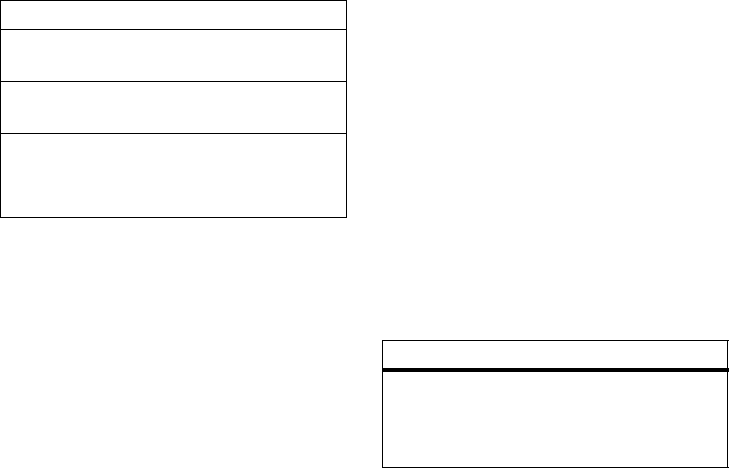
32
essentials
check delivery status
If a message was successfully sent and you
set the message to confirm delivery, you can
check the delivery status:
1
Scroll to the message you want to view.
2
Press
/
>
Delivery Status
.
delete sent messages
1
Scroll to the message you want to delete.
2
Press
K
under
Delete
.
3
Press
K
under
Yes
to confirm.
delete all unlocked sent messages
1
Press
/
>
Delete All
.
2
Press
K
under
Yes
to confirm.
customize messaging
Find it:
/
>
E
>
/
>
Setup
.
This option is available from many
context-sensitive menus.
The following options become available:
Off:
read receipts will not be generated.
On Delivery:
read receipt will be generated
when a message is delivered.
When Read:
read receipt will be generated
when a message is read.
Both:
read receipt will be generated when a
message is delivered and read.
Note:
Available with MMS only.
option
Signature:
Allows you to create a signature
that is automatically inserted at the end of
your messages. Signatures can be edited
before sending the message.

33
essentials
manage memory
Your text Inbox and Sent Items hold 200
messages each. The Outbox, and Drafts
folder hold up to 30 messages each. If they
are full, you cannot receive messages, send
messages, or save drafts until you delete
some items.
Note:
Media files and Java applications can
affect the available amount of memory on
your phone. If you run out of memory and
your Inbox, Sent Items, Outbox, and Drafts
folder are empty, delete unwanted media files
and Java applications to free up memory.
To view the amount of memory available in
your text inbox:
Find it:
Press
/
>
E
>
/
>
Setup
>
Memory Size
.
MMS setup
Find it:
/
>
E
>
/
>
Setup
>
MMS Setup
.
Quick Notes:
Lets you create new Quick Notes
and edit or delete Quick Notes you created.
Cleanup:
Controls how long messages remain
in the
Inbox
and
Sent Items
before being
deleted.
Report Default:
Allows you to be automatically
notified when your message is delivered.
Memory Size:
Shows a report on used and free
memory in your phone.
MMS Setup:
opens a submenu to set MMS
options.
Note:
Available with MMS only.
Text Message Setup:
opens a submenu to set
text messaging options.
Note:
Available with MOSMS only.
option

34
essentials
This option is available from many
context-sensitive menus when you are using
MMS.
The following options become available:
text message setup
Find it:
/
>
E
>
/
>
Setup
>
Text Msg setup
.
This option is available from many
context-sensitive menus when you are using
MOSMS.
The following options become available:
new quick notes and reply
phrases
create quick notes or replies
1
From the Setup menu, select
Quick Notes
, or
select
MMS Setup
>
Replies
.
2
Select
[New Quicknote]
, or
[New Reply]
.
option
Friendly Name:
Allows you to create a friendly
name. Your friendly name is displayed in the
From
field on other iDEN handsets when
your message is received.
Download Options:
Controls whether your phone
downloads new messages. Set this option
to
Automatic
if you want your phone to
download new messages automatically.
Select
Manual
if you want your phone to
prompt you before downloading new
messages.
Replies:
Lets you create or edit and delete
reply phrases you created.
option
Srvc Cntr No:
Allows you to enter a service
center number.
Expire After:
Allows you to set the number of
days before a message expires.
35
essentials
3
Enter text from the keypad and press
r
.
edit quick notes or replies
You can edit only Quick Note phrases you
have created.
1
From the Setup menu, select
Quick Notes
, or
select
MMS Setup
>
Replies
.
2
Select the quick note or reply you want to
edit.
3
Edit the text and press
r
.
delete quick notes and reply phrases
1
From the Setup menu, select
Quick Notes
or
MMS Setup
>
Replies
.
2
Scroll to the quick note or reply you want
to delete.
3
Press
K
under
Delete
.
4
Press
K
under
Yes
to confirm.
Note:
You can delete only reply phrases you
have created.
delete all quick notes
1
From the Setup menu, select
Quick Notes
.
2
Press
/
>
Delete All
.
3
Press
K
under
Yes
to confirm.
cleanup options
The cleanup option controls how long
messages remain in the Inbox and Sent Items
before they are deleted. You set the cleanup
option for the Inbox and Sent Items
separately.
The clean up option deletes only read,
unlocked messages and sent messages.
Find it:
/
>
E
>
/
>
Setup
>
Cleanup.
1
Select
Inbox
or
Sent Items
.
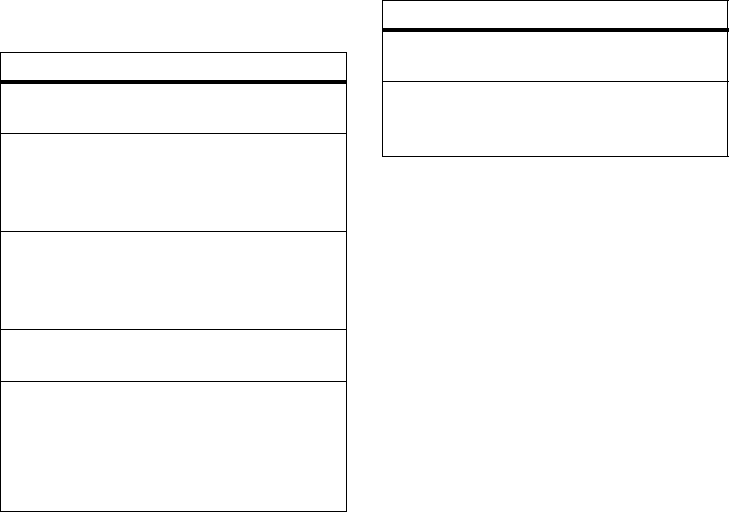
36
essentials
2
Choose a clean up option from the
following list:
3
Press
K
under
Yes
to automatically delete
messages now or press
K
under
No
to
delete messages later.
delete all messages
To delete all read, unlocked messages from
the Inbox, all messages in the Drafts folder, all
successfully sent messages in Sent Items, or
unsent messages in the Outbox:
Find it:
/
>
E
.
1
Select
Inbox
,
Drafts
,
Sent Items
, or
Outbox
.
2
Press
/
>
Delete All
.
option
Off:
Messages are never automatically
deleted.
5 Messages:
If you have more than 5
messages, messages are deleted in the
order they were received, starting with the
oldest, until 5 are left.
10 Messages:
If you have more than 10
messages, messages are deleted in the
order they were received, starting with the
oldest, until 10 are left.
1 Day
:
Messages are deleted if they are older
than 1 day.
3 Days:
Messages are deleted if they are
older than 3 days.
With these options, messages are deleted
when you exit the message center after
setting the option.
FirstIn FirstOut:
Messages are deleted as
necessary on a FirstIn FirstOut basis.
Custom:
Lets you create a clean-up option of
up to 199 messages or 99 days for the
Inbox and Sent Items.
option

37
essentials
3
Press
K
under
Yes
to confirm.
delete a thread
To delete a thread from the Inbox:
1
From the Inbox, select a thread.
2
Press
/
>
Delete Thread
.
3
Press
K
under
Yes
to confirm.
message notifications
When you receive a message, your phone
notifies you with text on the display, a
notification tone or vibration.
You can access the message or dismiss the
notification.
If you dismiss the notification, the message is
not deleted. It can be accessed through the
message center.
If you are not on a phone call when you
receive a message, your phone sounds a
notification tone every 30 seconds until you
access the message or dismiss the alert.
If you are on a call when you receive a
message, your phone may sound a
notification tone during the call or after you
end the call, depending on how you set your
notification options.
set notification options
To control whether your phone sounds
message notification tones while you are on a
phone call:
Find it:
/
>
u
>
Phone Calls
>
Notifications
.
Select from the following options:
option
Receive All
: Tones sound during calls for all
types of messages.
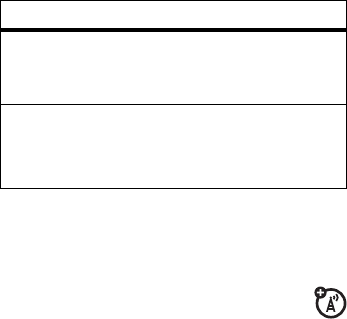
38
essentials
To set notification options during a call press
/
>
Call Setup
>
Notifications
.
using your handset
as a modem
Your phone can be connected to a computer
via USB for use as a modem. For more
specific information on how to setup your
phone for use with your computer please visit
www.motorola.com/support
and look under the FAQ
section.
Message Mail Only
: Tones sound during calls for
mail messages; tones for all other types of
messages are held until you end calls.
Delay All
: Tones for all types of messages are
held until you end calls.
Note:
Delay All
is the default setting.
option
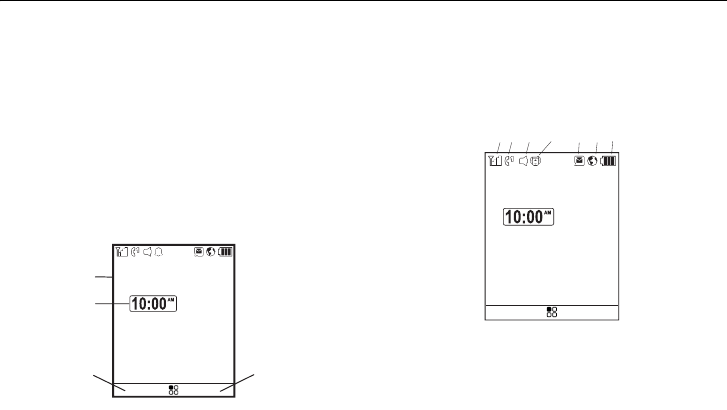
39
basics
basics
See page 1 for a basic phone diagram.
display
The home screen shows when you turn on
the phone. To dial a number from the home
screen, press number keys and press
`
.
Note:
Your home screen may look different.
Soft key labels show the current soft key
functions. For soft key locations, see page 1.
status indicators
Status indicators are shown at the top of the
home screen:
1Signal Strength Indicator:
Vertical bars
show the strength of the network
connection. You can’t make or receive
calls when
~
shows.
Contcs Mesgs
Ready
5/10/09
Date
Right
Soft Key Label
Left
Soft Key Label
Time
1 2 3 4 5 6 7
Contcs Mesgs
Ready
5/10/09

40
basics
2Active Phone Line:
%
indicates phone
line 1 is ready to make calls;
'
indicates
phone line 2 is ready to make calls.
3Speaker On/Off:
Sounds associated with
Private calls and group calls can be set to
come through the earpiece rather than
through the speaker.
4Ringer Vibe On/Off:
Your phone is set to
not ring.
5Message Indicator:
Shows when
you receive a text message, MMS
message, and voice mail.
6 Packet Data:
Your handset is ready to
transfer packet data or is transferring
packet data when it shows a blinking
arrow.
7 Battery Charge Indicator:
A fuller battery
indicates a greater charge. Recharge the
battery when your phone shows
Low Battery
.
main menu
All your phone’s features can be accessed
through the main menu. You can set the main
menu to appear as
List View
,
Tab View
or
Icon View
.
Find it:
/
>
u
>
Display/Info
>
Menu View
.
carousel menu
The Carousel Menu allows you to access up
to nine applications from your phone’s idle
screen.
accessing an application
1
Using the navigation key, scroll left or right
until you highlight the desired application.
2
Press
r
to launch the application.
Note:
Availability of the Carousel Menu is
dependent on your service provider.

41
basics
auto hide
1
Press
/
>
u
>
Personalize
>
Carousel
>
Auto Hide
.
2
Select from
Always On
,
2 seconds
,
4 seconds
, or
8 seconds
.
Note:
When
Auto Hide
is set to
Always On
, the
Carousel Menu will always be visible on the
idle screen.
assigning applications
1
Press
/
>
u
>
Personalize
>
Carousel
.
2
Highlight the position on the Carousel
Menu you would like the application to
occupy and press
r
.
3
Highlight an application and press
r
to
select it.
text entry
Your phone provides convenient ways to enter
words, letters, punctuation, and numbers
whenever you are prompted to enter text (for
example, when adding a Contacts entry or
when using Text Messaging).
change the character input mode
1
When you see a screen where you can
enter text, press
/
to change the
character input mode.
2
Select one of the following options:
entry method
Alpha
Press a key several times for
different characters.
Word
Enter words using a predictive
text entering system that lets
you enter a word with fewer
keypresses.

42
basics
Tip:
When entering text, press and hold
#
to change letter capitalization (
Abc
>
ABC
>
abc
).
word method
The Word text input method lets you enter
text into your phone by pressing keys just
once per letter.
The Word text input method combines the
groups of letters found on each phone key
with a fast-access dictionary of words, and
recognizes what you want to text as you type.
It first offers the most commonly-used word
for the key sequence you enter and lets you
access other choices with one or more
presses of the
0
key or ny pressing the
navigation key up or down. You may also hold
the navigation key down to display a pop-up
list of choices.
enter a word using “word” method
character input
1
Select the
Word
character input method.
2
Press the corresponding keys once per
letter to enter a word (for example, to
enter the word
Bill
, press
2455
).
(If you make a mistake, press
*
to erase
a single character. Press and hold
*
to
delete an entire entry.)
Symbols
Enter symbols.
Numeric
Enter numbers by pressing the
numbers on the keypad.
Text Input
Settings
Selects the desired entry
languages and Word Prediction
features.
Insert
Selects a item to be inserted,
such a picture, an audio/video clip
or a voice recording.
Note:
available only when using
MMS messaging.
entry method

43
basics
3
To accept a word and insert a space,
press
#
.
To accept a word completion (such as
Billion when you entered Bill), press
;
right.
If you get a word you don’t want, you can
press the
0
key to see more word
choices and pick the one you want.
alpha method
To enter characters by tapping the keypad:
1
Select the
Alpha
method.
2
Press the corresponding keys repeatedly
until the desired letter appears. (For
example, to enter the word
Bill
, press
2
twice,
4
three times,
5
three times,
and
5
three times again. If you make a
mistake, press
Delete
to erase a single
character. Press and hold
Delete
to erase an
entire word.)
By default, the first letter of an entry is
capitalized and the following letters are
lowercased. After a character is entered, the
cursor automatically advances to the next
space after two seconds or when you enter a
character on a different key.
Characters scroll in the following order:
characters
1
Space . 1 ? ! , @ & : ; “ - ( ) ‘ ¿
¡ %
£ $ ¥
2
A B C 2 Á Ã Â À Ç
3
D E F 3 É Ê È
4
G H I 4 Í Ì
5
J K L 5
6
M N O 6 ñ Ó Õ Ô Ò
7
P Q R S 7 ß
8
T U V 8 Ú Ü Û Ù
9
W X Y Z 9
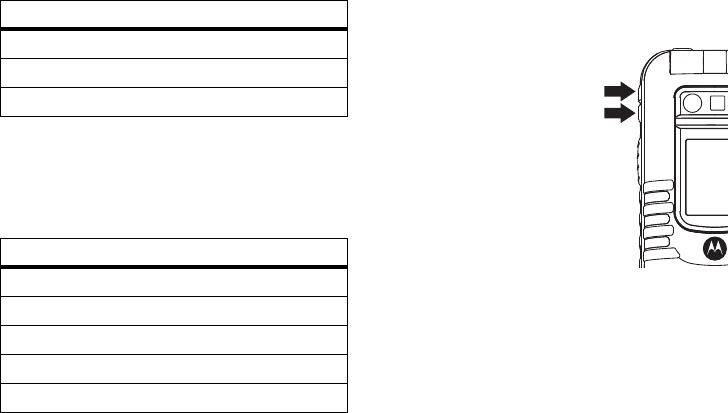
44
basics
When entering text, press and hold
#
to
switch between lowercase and uppercase
letters. The icons in the upper left-hand corner
of the screen show the character type.
volume
Press the volume keys up
or down to:
•
turn off an incoming
call alert
•
change the earpiece
volume during calls
•
change the ringer
volume from the
home screen
Tip:
You can quickly set your ringer to
Vibrate All
by holding the down volume
key in the home screen.
0
+ - 0 * / \ [ ] = > < # §
#
Space / Shift
*
Back
character type
Q or T
Lowercase
R or U
Uppercase
S or V
Shift Lock
W
Numerical
X
Symbols
characters
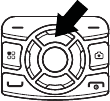
45
basics
navigation key
Press the navigation key
up, down, left, or right to
scroll to items in the
display. When you
highlight the desired
item, press
r
to select
it.
handsfree speaker
You can use your phone’s handsfree speaker
to make calls without holding the phone to
your ear.
During a call, press
K
under
Speaker
to turn
the handsfree speaker On.
The handsfree speaker stays on until you
press
K
under
Speaker
again.
transmitters
Consult airline staff about the use of the
Transmitters Off feature during flight. Turn off
your phone whenever instructed to do so by
airline staff.
Transmitters Off turns off your phone’s calling
and Bluetooth features in situations where
wireless phone use is prohibited, but you can
use the phone’s other non-calling features
when Transmitters is turned Off.
Find it:
/
>
u
>
Advanced
>
Transmitters
>
Off
.
use GPS with map
software
Your phone can be connected to a PC, laptop,
or PDA via Bluetooth and USB for use as a
GPS receiver. For more specific information
on how to setup your phone for use with your
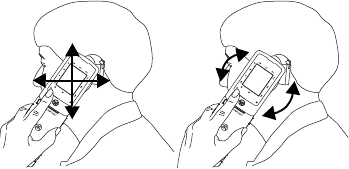
46
basics
computer please visit
www.motorola.com/support
and look under the FAQ section.
features for the hearing
impaired
using your phone with a
hearing aid
For best results use the following optimization
procedures and handset setting. They
generally apply as well for users with cochlear
implants:
optimize your handset position and
orientation
While in a phone call slide your phone up and
down, then left and right until best
microphone coupling is obtained. You also
may need to adjust your hearing aid (HA)
volume setting
.
If your HA has a telecoil, activate its switch,
then also rotate the handset as illustrated to
align the telecoils.
Note:
Some automatically switched hearing
aids may need an auxiliary switching magnet.
If you are unsure whether your HA is telecoil
equipped or needs an auxiliary magnet,
please refer to your HA user guide or contact
a hearing aid professional or supplier.
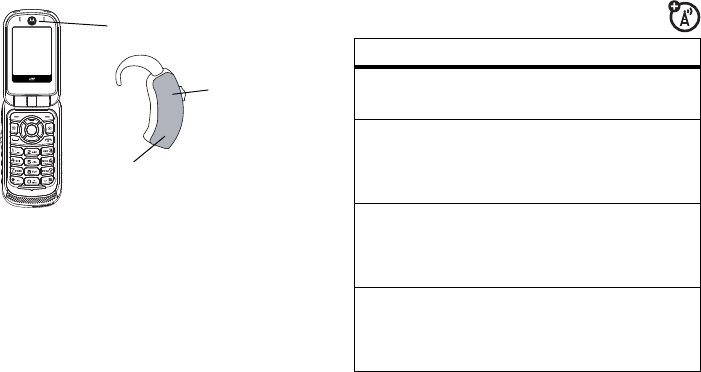
47
basics
choose your hearing aid setting
Find it:
/
>
u
>
Phone Calls
>
Hearing Aid
.
1
Set this option to
Microphone
. Microphone
coupling is now optimized.
or
2
Set this option to
Telecoil
. Handset meets
US federal requirements for telecoil
coupling sound or set this option to
Off
(factory default). This is the setting for non
HA users.
TTY
Note:
The TTY device must be connected to
the phone through the micro-USB port.
A 2.5 mm to micro USB adapter is required to
support TTY.
Approximate telecoil location is just
above the battery.
Approximate telecoil location is within
6-13 mm of this location.
Off - Shut off
M - Microphone
T - Telecoil
feature
turn On TTY
feature
Press
/
>
u
>
Phone Calls
>
TTY
>
Use TTY
>
On
.
choose TTY
mode
Press
/
>
u
>
Phone Calls
>
TTY
>
Type
.
Select from
TTY
,
VCO
or
HCO
.
change the
TTY baud
rate
Press
/
>
u
>
Phone Calls
>
TTY
>
Baud
.
Select
45.45
or
50.00
.
change TTY
mode
during a call
While in the TTY call, press
/
>
In Call Setup
>
TTY
>
Type
.
Select from
TTY
,
VCO
or
HCO
.

48
basics
security features
Note:
You can make emergency calls on a
locked phone (see page 86).
lock and unlock keypad
To lock your phone’s keypad, press
/*
.
feature
phone lock
To lock the phone press
/
>
u
>
Security
>
Phone Lock
>
Lock Now
or
Auto Lock
.
keypad lock
To lock the keypad press
/
>
u
>
Security
>
Keypad Lock
>
Lock Now
or
Auto Lock
.
enable SIM
PIN
Press
/
>
u
>
Security
>
SIM PIN
>
On
.
enable GPS
PIN
Note:
When you receive
your phone, your GPS PIN is
0000.
To change your GPS PIN
press
/
>
u
>
Security
>
Change Passwords
>
GPS PIN
.
Enter the current GPS PIN
and enter the new four to
eight digit GPS PIN.
Re-enter the new four- to
eight-digit GPS PIN to
confirm.
change SIM
PIN
Press
/
>
u
>
Security
>
Change Passwords
>
SIM PIN
.
feature
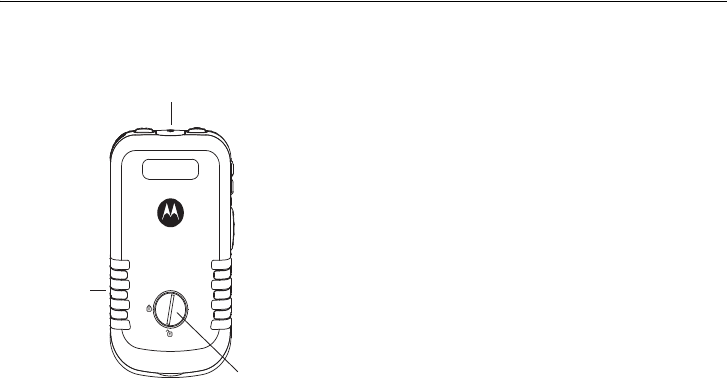
49
main attractions
main attractions
water resistance
Your phone is water resistant and can be
immersed in up to one meter of water for no
more than 30 minutes.
Warning:
In order for your phone to be water
resistant the battery door must be properly
attached and locked, and the headphone jack
and microUSB port must be properly sealed.
Failure to do so will result in water damage to
your phone. If the phone is immersed in more
than one meter of water or is submerged for
more than 30 minutes, water damage will
occur.
multimedia
Your phone comes with several multimedia
applications to let you access pictures, videos,
and audio files stored in your phone’s memory
or in the Audio, Music, Podcast, Image and
Video folders on a memory card inserted in
your phone’s memory card slot:
MicroUSB
Port
Battery Door
Latch
Headset Jack
50
main attractions
•
Media Center
is a central repository to
view all supported multimedia files on
your device or your memory card.
Note:
The Media Center cannot read
the Music and Podcast folder from the
SD card.
•
My Music
provides an enhanced music
player for music and podcast files.
•
My Images
provides a slide show, image
browser and image editor.
•
My Videos
plays video files on the display.
•
Camera
lets you take still pictures.
•
Camcorder
lets you take short movies.
•
Ringtones
lets you purchase and preview
ringtones for your phone.
•
VoiceRecord
lets you record audio notes to
yourself.
In addition, the following audio files can be
accessed through the media center:
•
VoiceRecords
•
Musical ring tones in the list of ring
tones
•
Audio files saved from MMS messages
received
•
Audio files downloaded to your phone
Because the memory card inserted in your
phone may contain files saved to it using a
device other than your phone, not all types of
pictures, videos, and audio files on the
memory card may be accessed through your
phone’s media center.
Items in the media center can be sent in
MMS messages and with Bluetooth. See
“MMS features” on page 22 and
“Bluetooth
®
” on page 79.

51
main attractions
Pictures in the media center can be sent in
Private calls using Send via PTT. See “PTX
features” on page 69.
Note:
If the picture size exceeds 95k, it will
be resized before it is sent in an MMS
message. However, the original image stored
in the Media Center will remain unchanged.
Media files supported by the Media Center
include:
Format Bit Rate / Info Sampling
Rate
AAC
(MPEG4
AAC-LC)
.aac
*
, .3gp,
.m4a, .3ga,
.mp4
Up to 320kbps 48 kHz
AAC+
.aac
*
, m4a,
.3ga, .mp4
Up to 128 kbps
(16 to 128 kbps) Max: 48
kHz
AAC+
Enhanced
.aac
*
, .m4a,
.3ga, .mp4
Up to 320 kbps
(16 to 320 kbps)
Up to
48 kHz
AMR-NB
.amr, .3gp,
.3ga, .mp4
4.75 kbps – 12.20
kbps (supports all
3GPP specified
rates)
8 kHz
AMR-WB
.awb, .3ga,
.3gp
6.6 kbps - 23.85
Kbps (supports all
3GPP specified
rates)
16 kHz
iMelody
.imy 1 – 3.5 kHz
Monophonic N/A
MIDI XMF
.xmf, .mmf,
.xmf0, .xmf1,
.mxmf
64 channels N/A
Format Bit Rate / Info Sampling
Rate

52
main attractions
MIDI
Stand
.mid, .midi,
.smf
64 channels N/A
MP3
.mp3
*
,
.mpga
*
Up to 320kbps Up to
48 kHz
PCM 16-bit
Linear
.wav, .au
Up to 1536 kbps Up to 48
kHz (8,
11.05, 12,
16, 22, 24,
3, 44, 48
kHz)
PCM 8-bit
Linear
.wav, .au
Up to 1536kbps Up to
48 kHz
PCM 8-bit
A-law
.wav, .au
Up to 704 kbps Up to
48 kHz
Format Bit Rate / Info Sampling
Rate
PCM 8-bit
mu-law
.wav, .au
Up to 704 kbps Up to 44
kHz (8,
11.05, 12,
16, 22, 44
kHz)
Real Audio
LBR (Cook)
.rm, .ra, ram
Up to 96 kbps Up to
44.1 kHz (8,
11, 22, 44
kHz)
Real Audio
Sipro
(ACELP
®
.net)
.rm, .ra, ram
5 kbps (fixed
rate)
8.5/6.5 kbps (dual
rate)
16 kpbs (wide
band)
8 kHz
8 kHz
16 kHz
Real
Audio 10
.rm, .ra, ram
Up to 192 kbps Up to
48 kHz (8,
11, 12, 16,
22.05, 24,
32, 44.1, 48
kHz)
Format Bit Rate / Info Sampling
Rate

53
main attractions
(*) These formats support album art and lyrics.
Supported video file formats include:
The Media Center also supports the
GIF
,
JPEG
,
PNG
, and
WBMP
image file formats.
WMA v9 L2
(also WMA
v3, v7, v8)
.wma
*
Up to 320 kbps 48 kHz
Format Resolution /
Bit and
Frame Rate
Extension
MPEG4 +
AMR-NB
MPEG4 +
AMR-WB
MPEG4 + AAC /
AAC+ /Enhanced
AAC+
352 x 288
and 320 x
240 (up to
256 kbps);
176 x 144 and
128 x 96 (up
to 128 kbps);
up to 30 fps
.mp4, .3gp
Format Bit Rate / Info Sampling
Rate
H.263 + AMR-NB
H.263 + AMR-WB
H.263 + AAC /
AAC+ /Enhanced
AAC+
352 x 288 (up
to 256 kbps);
176 x 144 and
128 x 96 (up
to 64 kbps);
15 fps
.3gp
Real Video G2 / 8
/ 9
Up to 320
kbps, 320 x
240, 15 fps
.rm, .rmvb
H.264
Up to 320
kbps, 320 x
240, 15 fps
.mp4, .3gp
WMV8 / WMV 9
Up to 384
kbps, 320 x
240, 24 fps
.wmv, .asf
Format Resolution /
Bit and
Frame Rate
Extension
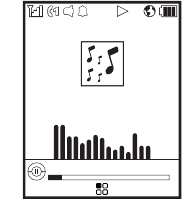
54
main attractions
my music
Your handset includes a music player that you
can use to play music files stored in the
phone memory and the MUSIC/AUDIO/
PODCAST directories on the memory card
inserted in your phone.
The music player will display the name of the
song playing and the artist.
The music player groups the music files into
folders and lists. When you select a music file
to play, the music player plays this file, then
plays the other music files grouped with it.
The music player also plays podcasts you
download to your computer and then save on
the Podcast directory on your phone’s
memory card. You can mark highlights within
a podcast file to help you find the parts you
most want to listen to.
If your service provider offers MMS, you can
send details of the podcast to a friend and
send feedback to the podcast creator using
MMS messages.
understanding the memory
card folder structure
When you first insert the memory card into
your phone, five folders are created:
Audio
,
Image
,
Music
,
Podcast
, and
Video
. In order to view
files stored on the memory card, you must
store the given file in its corresponding format
Pause Back
The Song
The Band
Now Playing...
0:39 3:38
55
main attractions
folder: audio files such as ring tones, and
voice recordings to the
Audio
folder, pictures to
the
Image
folder, music files such as songs to
the
Music
folder, Podcasts to the
Podcast
folder
and videos to the
Video
folder.
filename rules
When naming files stored on the memory
card, the following rules apply:
•
The filename can contain UTF8
characters, including ASCII, however
only supported characters will be
displayed.
•
The filename can be up to 255
characters long, including the file
extension, however only the first 32
characters will be displayed.
Warning:
If a music file name is longer than
255 characters, including the file format
(.MP3), the song will not be visible on the
player and therefore can not be played. This
can be corrected by renaming the file and
replacing it on the card.
play music files
Find it:
/
>
j
>
My Music.
1
Scroll to choose how you want your music
played (Songs, Playlists, Albums, etc.).
Tip:
The Songs folder contains all the
music files on the memory card in a single
list.
2
To play the first music file in the folder,
press
K
under
Play
. (If the selected folder
contains subfolders, this plays the first
music file in the first of the subfolders.)
Press
r
to view the folder’s contents.
Scroll to a music file and press
K
under
Play
to play the first music file in it.
Any time you are viewing a list of folders with
the music player, you can scroll to a folder and
press
K
under
Play
to start playing the

56
main attractions
contents of that folder or press
K
to view the
contents of the folder.
To stop viewing a folder and return to the
folder or list that contains it, press
K
under
Back
.
play music while loading files
The first time the music player finds music
files on your memory card, it loads and
organizes these files. This may take a long
time for a large number of files.
To play music while files are loading:
Find it:
/
>
j
>
My Music
.
1
Scroll through songs and folders while
loading is going on the background.
2
Scroll to a music file or folder and press
K
under
Play
or
r
.
The following options become available
through the navigation panel:
set up the music player
Find it:
/
>
j
>
My Music
>
/
>
Setup
option
Pause and Resume:
Press
K
under
Pause
or
r
to pause, and press
K
under
Play
or
r
to
resume playing paused music files.
Skip to Next or Previous:
Press and release
;
right or left to skip to the next or previous
music file.
Fast Forward and Rewind:
Press and hold
;
right
or left for 2 seconds to fast forward or to
rewind.
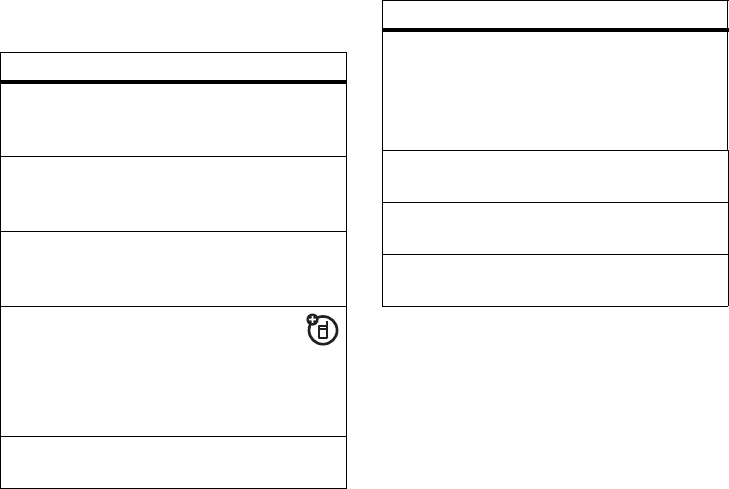
57
main attractions
The music player can be set up with the
following options by pressing
/
>
Setup
:
work with playlists
Playlists are lists of music files you create
from the files already available through My
Music.
Playlists enable you to organize music files,
but they do not change anything in other
folders or on the memory card. Adding or
option
Shuffle:
Lets you set the music player to play
the music files in a list or folder in random
order.
Repeat:
Lets you set the music player to play
one or all the music files in a list or folder
repeatedly.
Visuals:
Lets you choose among different
types of visual equalizers which sync with
the Music.
3D Music:
Lets you experience surround
effects when the handset is tethered
to a stereo headset.
Setting the
3D Music
feature to
On
, allows you
to select effects from the list of
Music Reverbs
.
Album View:
Lets you choose to view either a
list view or an image view.
Auto Update:
Lets you reload all music files
every time you launch My Music. If you set
Auto Update
to
Off
, it will follow the last known
music library configuration in order to save
loading time.
Equalizer:
Lets you customize the sound of the
music player.
View:
Lets you choose between
Default
view
and
Folder
view.
Music Reverbs:
Lets you
choose a 3D sound
effect for use with the 3D Music feature.
option

58
main attractions
deleting a file on a playlist does not copy,
delete or move it.
create a playlist
Find it:
/
>
j
>
My Music
>
Playlists
>
[Create New]
.
1
Enter a playlist name.
Note:
If you do not assign a name, the
playlist is named
Playlist
followed by a
number. For example, the first playlist you
create without naming is automatically
named
Playlist-1
.
2
Select
[Add Songs]
. A list of all music files
appears.
Tip:
For options to help you sort through
this list, press
/
.
3
Select each file you want on the playlist. A
checkmark appears by each selected file.
Tip:
To deselect a selected item, scroll to
a selected file and press
r
.
4
When you are finished selecting files,
press
K
under
Done
and
K
under
Save
.
The following options are available for existing
playlists:
option
Reorder Songs in a Playlist:
You can change the
order of the music files while creating or
editing the playlist by pressing
/
>
Reorder Songs
. Scroll to the song you want to
move, press
K
under
Grab
, and then scroll
to the place where you want the song to
appear and press
K
under
Insert
.
Remove Songs:
You can remove some or all
songs while creating or editing a playlist.
Before you have saved a new playlist or
while editing a playlist, scroll to the song
you want to remove and press
/
>
Remove
Song
and press
r
, or you can select
Remove All Songs
. Press
K
under
Yes
to
confirm and
K
under
Save
.

59
main attractions
use the favorites playlist
The
Favorites
playlist is a permanent playlist. You
can
Add To Favorites
, remove and change the
order of the music files, but you cannot
rename or delete music files.
Find it:
/
>
j
>
My Music
>
Songs
.
Select the song you want to add to your
favorites and press
/
>
Add To Favorites
.
Reorder Playlists:
You can change the order of
the playlists in the
Playlists
folder. Press
/
>
Edit playlist
>
Reorder Playlists
. Scroll to the
playlist you want to move and press
K
under
Grab
, and then scroll to the place
where you want the playlist to appear and
press
K
under
Insert
.
Delete a Playlist:
While in the music player
select
Playlists
. Scroll to the playlist you want
to delete and press
/
>
Delete Playlist
. Press
K
under
Yes
to confirm.
Edit a Playlist:
You can change a playlist name,
add music files, remove music files, and
change the order of the music files. Select a
playlist and press
/
>
Edit Playlist
. Make
changes and press
K
under
Save
.
option
Delete all Playlists:
While in the music player
select
Playlists
. Press
/
>
Delete All Playlists
and press
K
under
Yes
to confirm.
Note:
This deletes all playlists except the
Favorites playlist.
Reload Music:
Searches your memory card for
music files.
option

60
main attractions
work with podcasts
Find it:
/
>
j
>
My Music
>
Podcasts
.
Note:
The Podcasts
folder is empty until you
download podcasts from your computer.
1
Scroll to view individual podcast episodes
or folders containing multiple episodes of
the same program.
2
Press
r
to view the podcast episodes
within a folder or the details screen of an
individual podcast episode.
You can pause, resume, fast-forward, and
rewind just as with any other music file.
Some functions differ when playing a podcast:
•
Pressing
r
when you have scrolled to
a podcast displays a screen showing
podcast details, but does not play the
podcast. To play the podcast, press
K
under
Play
. After you begin playing the
podcast, pressing
r
pauses and
resumes the podcast.
•
If the podcast you are playing contains
highlights, pressing and releasing the
;
right or left skips to the next or
previous highlight within the podcast,
or to the beginning or end of the
podcast.
highlights
Highlights are portions of a podcast that are
marked to help you find them more easily. You
can use the music player to add and delete
highlight markers. Press and release (don’t
hold) the
;
right or left to find them.
You can play all the highlights in a podcast and
skip everything that is not marked as a
highlight using
Highlights Only
.

61
main attractions
add a highlight marker
1
While playing a Podcast press
/
>
Add Highlights
.
2
Press
K
under
On
to mark the beginning.
3
Go to the point in the podcast that you
want to mark as the end of the highlight
and press
K
under
Off.
4
Press
K
under
Back
.
Tip:
Highlight markers can be deleted by
pressing
/
>
Clear
or pressing
/
>
Edit Highlights
>
/
>
Clear All Highlights
from the
Podcasts menu.
send podcast information
You can only share podcast details with
others. If you want to share podcast details,
you have saved to your memory card, you can
send it in an MMS message that can be saved
and downloaded onto their computer.
Find it:
/
>
j
>
My Music
>
Podcasts
>
/
>
Forward Details
>
Send.
background music
Your handset has the capability to play music
in the background while you are accessing
other features like
Settings
,
Media Center
,
Bluetooth
,
GPS
,
Contacts
,
MMS
,
Datebook
,
Memo
,
Recent Calls
, and
others.
You can also enjoy listening to your favorite
background music while browsing the web,
reading news or checking the weather.
play music in the background
Find it:
/
>
j
>
My Music
>
Songs
.
1
Select a music file and press
r
to play
the song.
2
Press
/
>
Hide Player
.

62
main attractions
The music player continues playing and the
handset returns to the home screen. To jump
back to the music player, press
K
under
Music
.
my images
My Images lets you easily browse, edit and
view a slide show of images on your phone or
memory card.
my images menu
The My Images menu has many photo
management features. The following options
are available for images by pressing
/
>
j
>
My Images
>
/ >
and choose one of the
following:
option
Edit:
Displays several options for editing your
photos including:
Crop, Rotate/Flip, Color Adjustment,
Resize, Borders, Stamps, Text
and
Text Bubble.
Slideshow:
Starts a slide show containing
images from the currently highlighted
image.
Save as New:
Lets you save an image with a
new filename.
Preview:
Displays the highlighted image.
Rename:
Lets you rename the image
filename.
Delete Current:
Deletes the current highlighted
image.
Delete Multiple:
Lets you chose multiple images
to delete at one time.
Switch to Card/Switch to Phone:
Toggles between
images stored on the phone or memory
card.

63
main attractions
viewing images
Find it:
/
>
j
>
My Images
.
1
Press
/
>
Slideshow
to view a show of all
images in the current folder.
2
Press
;
left or right to switch between
viewing images on the phone and the
memory card. The
#
or
*
keys can
also be used to scroll the images.
my videos
My Videos lets you easily browse and view
video files on your phone or memory card.
Find it:
/
>
j
>
My Videos
.
viewing videos
To view a video, select a folder, highlight the
video file you want to play, and press
K
under
Play
or
r
to begin playback.
My Videos will display the video in portrait
mode by default.
Tip:
To change the default to landscape mode
press
/
>
Full Screen
.
my videos setup menu
Find it:
/
>
j
>
My Videos
>
/
>
Setup
Set as Wallpaper:
Sets the highlighted image as
the device wallpaper.
Set As Caller ID:
Allows you to assign the
highlighted image to a Contact.
Send Via BLuetooth:
Lets you send the image via
Bluetooth.
option
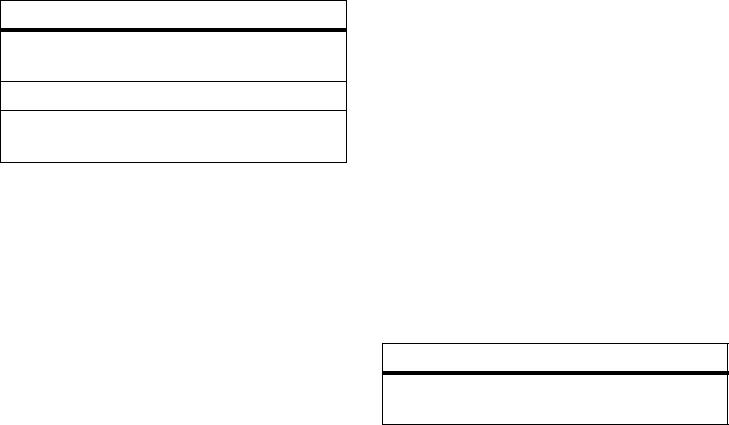
64
main attractions
The My Videos Setup Menu allows you to
change the following settings:
camera
You can save pictures taken with the
integrated camera in your phone’s memory or
memory card, and can access them through
the Media Center.
Pictures can be sent via Private Calls,
Bluetooth, or MMS message. You can also
assign them to Contacts entries, or set them
as your phone’s wallpaper.
access the camera
To access the camera with the flip open,
press
?
or press
/
>
j
>
Camera
.
To take pictures aim the camera lens and
press
K
under
Capture
or press
r
.
To save the picture, press
r
.
To discard the picture without saving it, press
K
under
Discard
.
To take a picture with the flip closed, press
?
or press
/
>
j
>
Camera
, close the flip,
and press
)
to take the picture.
From the camera viewfinder, you can press
/
to enter
Menu Options
.
The following options become available:
option
View:
Displays options for viewing your
videos as
Default
and
Folder
view.
3D Audio:
Lets you turn 3D audio
On
and
Off
.
Reverbs:
Lets you choose from a number of
3D audio settings.
option
[Help]:
Provides information on taking a
picture with the flip closed.
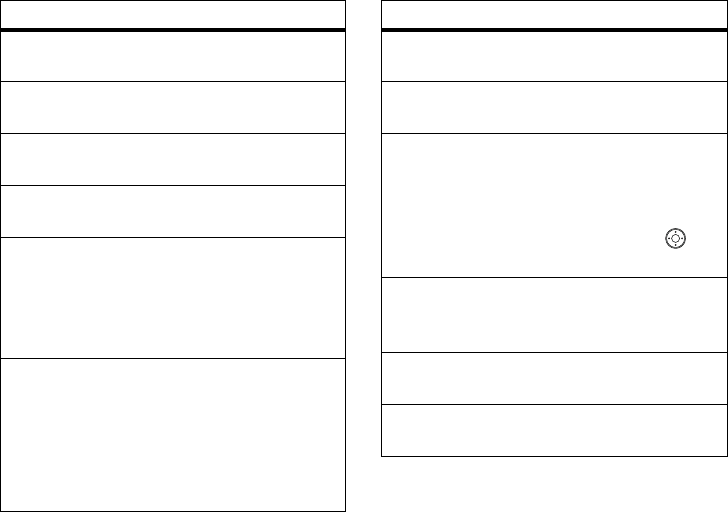
65
main attractions
Record Video
: To switch the camera to
camcorder mode.
Media Center
:
Opens the Media Center
application.
Zoom
: To set the camera’s zoom to
1x
,
2x
, or
4x
.
Remove Card:
To safely remove the memory
card from the phone.
Spotlight:
Allows you to turn the spotlight on
or off.
Session On
keeps spotlight turned on
when phone is in camera mode.
Only Once
turns the spotlight on for a single picture.
Session Off
keeps the spotlight turned off.
Self Timer:
Delay capturing the picture for a
selected number of seconds. The values
are:
Off
(default),
10 seconds
,
15 seconds
,
20
seconds
.
To turn off the timer before the picture is
captured, press
:
under
Cancel
.
option
GPS Tag:
Allows you to turn
GPS Tag
feature
On
or
Off
.
Picture Quality
:
Adjust the picture quality to
Normal
or
Fine
.
Picture Size
:
Set up the picture size to
Max
(1200x1600)
,
XL (1024x1280)
,
L (480x640)
,
M (240x320)
,
S (96x128)
,
Wallpaper1(176x220)
or
Wallpaper2 (120x160)
. You can also set picture
size from the viewfinder by pressing left
and right.
White Balance:
Sets the white balance to
Automatic
,
Sunny
,
Cloudy
,
Fluorescent
,
Tungsten
or
Night.
Exposure Control:
Adjusts the exposure of the
picture from -2 to +2.
Style:
Sets the type of picture effect to
Normal
,
Black and White
,
Sepia
,
Solarization
and
Negative
.
option

66
main attractions
access the media center
You can access the media center from the
camera at any time by pressing
/
>
Media Center
, except when you are using the
Camera Setup
menu or viewing the memory
screen.
The media center contains all your pictures,
music files, and videos located on your
phone’s memory. Press
*
or
#
to filter
your results.
customize the camera
Find it:
/
>
j
>
Camera
>
/
>
Camera Setup
The following options become available:
Memory Usage
: Shows the total amount of
Used
,
Free
, and total
Capacity
of the phone’s memory
and of the SD memory card.
Memory Card:
Allows you to
remove the
memory card,
set where videos are stored:
On Phone
or
Prefer On Card
, format the memory
card, and to display
Help
.
Camera Setup
: To access the camera set up
screen.
option
option
Ask for Name
:
If this option is
On
, you are
prompted to enter a name for each picture
before saving. Otherwise, pictures are
automatically saved with the date and a
number as their names.
Shutter Sound
:
Set the default sound the
camera makes when is taking a picture.
Default Size
:
Sets the default value for the
Picture
Size
option.
Default Quality
: Sets the default value for the
quality of the picture.
Spotlight Setting:
Select from
Always On
or
Off
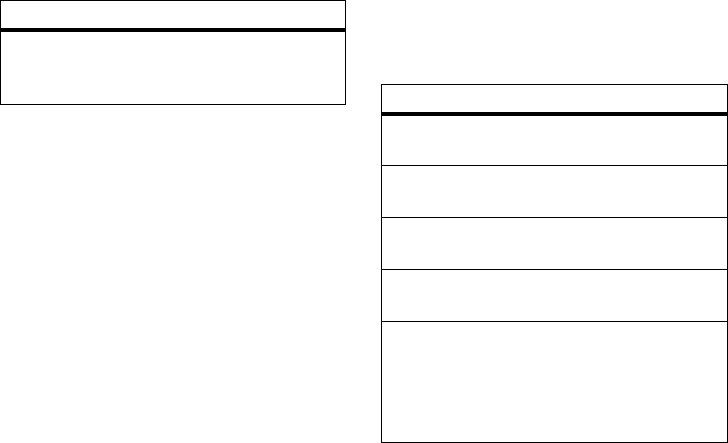
67
main attractions
camcorder
You can use your phone’s camcorder feature
to record videos.
Find it:
/
>
j
>
Camcorder
record video
1
Press
K
under
Record
, or press
r
.
2
To stop recording and discard the partially
recorded video, press
K
under
Cancel
.
3
To stop recording the video press
K
under
Stop
.
4
To save the recorded video, press
r
.
From the camcorder viewfinder, you can
press
/
to enter
Menu Options
.
The following options become available:
GPS Tag
: If this option is
On
, pictures will be
tagged with the geographic location of
where they were taken.
option
option
Media Center
:
Opens the Media Center
application.
Capture Picture
: To switch the camera to picture
mode.
Zoom
: To set the camera’s zoom to
1x
,
2x
, or
4x
.
Remove Card:
To safely remove the memory
card from the phone.
Spotlight:
Allows you to turn the spotlight on
or off.
Session On
keeps spotlight turned on
when phone is in camcorder mode.
Only Once
turns the spotlight on for a single video.
Session Off
keeps the spotlight turned off.
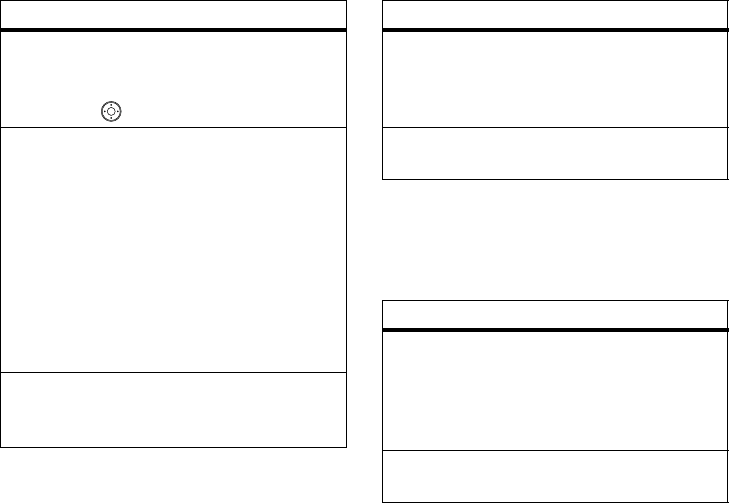
68
main attractions
customize the camcorder
Find it:
/
>
j
>
Camcorder
>
/
>
Camera Setup
The following options become available:
Video Size
:
Set up the picture size to
Min
(128x96)
,
Med (176x144)
, or
Max (352x288)
. You
can also set picture size from the viewfinder
by pressing left and right.
Video Length
:
Allows you to choose between
Short
, to limit video length for sending via
MMS message, or
Maximum
for longer
videos.
Note:
When set to
Maximum
, video length is
limited to 60 seconds when stored to your
phone’s memory. When stored to a
memory card, video length is limited to
available space on the memory card, or two
hours.
Memory Usage
: Shows the total amount of
Used
,
Free
, and total
Capacity
of the phone’s memory
and of the memory card.
option
Memory Card:
Allows you to
remove the
memory card,
set where videos are stored:
On Phone
or
Prefer On Card
, format the memory
card, and to display
Help
.
Camera Setup
: To access the camera set up
screen.
option
Ask for Name
:
If this option is
On
, you are
prompted to enter a name for each picture
before saving. Otherwise, pictures are
automatically saved with the date and a
number as their names.
Shutter Sound
:
Set the default sound the
camera makes when is taking a picture.
option
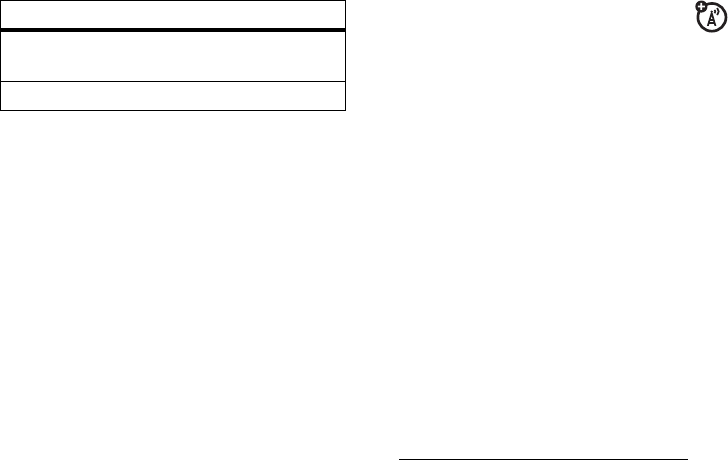
69
main attractions
deleting a recorded video
If you do not want to save the recorded video,
press
K
under
Discard
to delete the recorded
video and return to the video viewfinder.
sending video via MMS
message
To send the recorded video via an MMS
message, press
K
under
Send
. The video will
be automatically attached to a new MMS
message.
Note:
To ensure the video file is small enough
to be sent via MMS, set the
Camcorder
video
length to
Short
.
PTX features
With Push To View features, your phone can
send and receive the following items through
Private calls with other phones that have this
capability:
•
Short text messages
1
•
Pictures
1
•
Datebook events
•
My Info
•
Contact information
•
Location information
1
You can choose to send messages, pictures,
events,
My Info
,
Contacts
or
Location
information to
the Private ID you are engaged in a Private call
with, Private IDs on the
Recent Calls
list, and
Private IDs stored in
Contacts
.
Default Video Size
:
Sets the default value for the
Video Size
option.
Spotlight Setting:
Select from
Always On
or
Off
option
1. Additional charges may apply.

70
main attractions
When you make or receive a Private call, your
phone automatically determines whether the
phone you are engaged in a Private call with is
able to receive each of these items. Your
phone saves this information for as long as
the Private ID is on your
Recent Calls
list or is
saved in your
Contacts
. Your phone updates the
saved information each time you make or
receive a call to or from that Private ID.
Note:
You cannot send PTT feature items
during Talkgroup calls or SDGC calls.
send messages
The Push to Send Messages feature
lets you send short text messages through
Private calls.
When you send a message, it appears on the
display of the phone you are engaged in the
Private call with.
begin a message and choose a
recipient
You can begin a message during a Private call,
from the
Contacts
list, the
Recent Calls
list, or from
the
PT Manager
.
begin a message during a Private call
While in a Private call, press
/
>
Use PTT Feature
>
Send Message
.
Note:
The first time you send a message,
Messaging Fees May Apply Continue?
appears and you
are prompted to respond. Press
K
under
Yes
to acknowledge the message.
begin a message from the Contacts or
the Recent Calls list
1
From the
Contacts
or the
Recent Calls
list,
select the entry containing the Private ID
you want to send the message to.
2
Press
/
>
Use PTT Feature
>
Send Message
.
71
main attractions
begin a message from the PT Manager
The
PT Manager
lets you select the Private ID
you want to send the message to from
Contacts
or the
Recent Calls
list.
Find it:
/
>
N
>
PT Manager
>
Send Message.
Then select
A Contact
or
A Recent Call
to see a list
of entries from the
Contacts
or the
Recent Calls
list
that can receive messages.
create messages
After you have begun a message and chosen
a recipient, a screen appears that lets you
create the text of the message you want to
send. Your message may be up to 765
characters long.
You can choose from a list of ready-made
words or short phrases called Quick Notes.
You can use a Quick Note as it is or edit it
before you send it. Editing a Quick Note
changes the Quick Note for this message only
and will not change the Quick Note on the list.
send a completed message
After you have completed your message,
press the PTT button to send it.
receive messages
When you receive a message, a message
notification appears on the display.
To view the message: Press
K
under
View
.
To dismiss the message: Press
K
under
Dismiss
.
reply to a message
1
View the message.
2
Press
K
under
Reply
.
3
Create the message and press the PTT
button to send it.

72
main attractions
send pictures
You can send pictures stored in the
Media
Center
through Private calls. The picture you
send appears on the Private call recipient’s
display.
If the recipient accepts the picture, their
phone saves the picture. The picture then
appears in that phone’s recent call list.
The first time you send a stored picture after
turning the phone on,
Picture Fees May Apply
Continue?
appears and you are prompted to
respond.
Note:
You cannot make or receive Private
calls while transmitting or receiving a picture.
send a picture during a call
1
While in a Private call, press
K
under
Picture
or press
/
>
Use PTT Feature
>
Send Picture.
A list of pictures that can be included in a
Private call appears.
2
Select the picture you want to send.
3
Press the PTT button to send the picture.
4
Wait while the picture is transmitted. The
Private call is temporarily interrupted
while a picture is transmitted.
5
When prompted, press the PTT button to
resume the Private call.
start a call by sending a picture
from the media center
Find it:
/
>
j
>
Media Center
1
Scroll left or right to
Media: Pictures
.
2
Select the picture you want to send.
3
Press
/
>
Send Via...
>
Send Via PTT
.
4
Select
A Contact
or
A Recent Call
73
main attractions
A list of contacts that have Private IDs and
are able to receive pictures appears.
5
Select the name of the person you want
to send the picture to.
6
Press the PTT button to send the picture.
7
When prompted, press the PTT button to
resume the Private call.
from the PT Manager:
Find it:
/
>
S
>
PT Manager
>
Send Picture
.
1
Select
A Contact
or
A Recent Call
A list of contacts that have Private IDs and
are able to receive pictures appears.
2
Select the name of the person you want
to send the picture to.
3
Select
Browse Picture
or
Capture Picture
.
4
Press the PTT button to send the picture.
5
Once picture has been sent, when
prompted press the PTT button to resume
the call.
receive a picture
When someone sends you a picture, your
phone emits a tone or vibrates and a message
appears asking if you want to accept the
picture.
Pictures you receive are saved either to your
phone’s memory or SD card. They are
accessible through the media center.
When you see a message asking if you want
to accept the picture, press
Yes
to accept or
No
to decline.
clear a picture from the display
If you want to clear a picture from your
phone’s display while still on a call, press
/
>
Clear Screen
.

74
main attractions
send a datebook event
to send a datebook event during a
private call
1
While in a Private call press
/
>
Use PTT Feature
>
Send Event
.
Note:
If these options do not appear on
the menu, the Private ID you are engaged
in a private call with is not able to receive
Datebook events.
2
If you want to create a new datebook
event, press
K
under
New
and create the
event in your datebook. If you want to
chose an existing event do so.
3
If the event is a recurring event: Select
This Event Only
to send only the event
selected. Select
Repeat Events
to send all
occurrences of the event.
4
Push the PTT button to send the event.
send my info
1
While in a Private Call press
/
>
Send My Info via PTT
., and push the PTT button
to send.
or
2
From the home screen press
/
>
C
>
My Info
>
/
>
Send My Info via PTT
. Enter a
Private ID or press
K
under
Browse
to
chose a recipient from Contacts, Recent
Calls or Memo, and press
r
. Push the
PTT button to send.
set my info sending option
You can control what portion of the
information in
My Info
is sent and whether it is
sent automatically in every call or only when
you choose to send it.
Find it:
/
>
S
>
PT Manager
>
Configure
>
PTT My Info
>
Info to Send
75
main attractions
1
Select or remove the fields you want to
send.
2
Press
:
under
Done
.
The information your phone sends always
includes
My Name
, and
Private ID1
. You may also
send
Mobile, Other, IP
,
Private2, Work1, Work2, Home,
Email1, Email2, Fax
and
Pager
depending on your
sending options.
automatic sending
To control whether you send your information
automatically:
Find it:
/
>
S
>
PT Manager
>
Configure
>
PTT My Info
>
Auto Send
1
Select
On
or
Off
2
When you make a call in which your
information is sent automatically, the
name you entered in the
My Name
field of
My Info
appears on the display of the
recipient’s phone, even if your name and
Private ID are not stored in the recipient’s
Contacts.
send contact information
1
While in a Private Call press
/
>
Use PTT Feature
.
2
Select
Send Contact
and select the contact
information you want to send.
3
Push the PTT button to send.
or
1
From the home screen press
/
>
S
>
PT Manager
>
Send Contact.
2
Enter the Private ID number of the person
you want to send the Contact information
to or press
K
under
Browse
.
3
Select from
Recent Calls
,
Contacts
, or
Memo
.

76
main attractions
Select the contact information you want to
send and push the PTT button.
send your location
You can transfer your approximate
location information through Private calls to
other enabled phones. Using the integrated
GPS feature, the following location
information can be shared:
•
Time Stamped Latitude/Longitude
•
Relative Location or Direction and
distance from the sender in Miles or
Kilometers
Find it:
/
>
S
>
PT Manager
>
Send Location.
1
Select
A Contact
or
A Recent Call.
A list of contacts that have Private IDs and
are able to receive locations appears.
2
Select the name of the person you want
to send your location to.
3
Press the PTT button to send your
location.
Note:
The location information can be stored
in the recipient’s recent call list.
turn PTT features on and off
You can turn your phone’s ability to send and
receive messages, pictures, and Datebook
events and location info on and off.
You cannot turn your phone’s ability to send
and receive My Info and contact information
on and off.
Find it:
/
>
S
>
PTT Options
>
On/Off PTT Features
.
1
Check or uncheck Messages, Pictures,
Events or Location.
one touch PTT
Find it:
/
>
S
>
PTT Options
>
One Touch PTT.
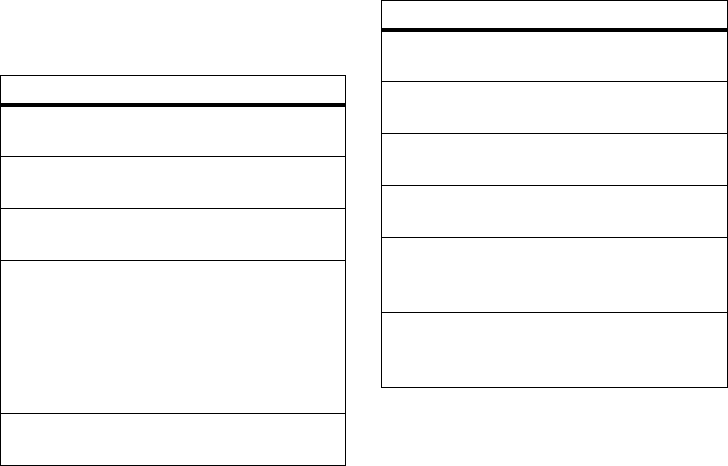
77
main attractions
One Touch PTT sets your phone to do any of
the following each time you press the PTT
button from the home screen:
option
Off
: Nothing happens when you press the
PTT button from the home screen.
Quick PTT
: Go to Quick PTT. See “quick PTT”
on page 78.
Last Call
: Call the most recent Private ID or
Group on the recent calls list.
Assigned Number
: Call a Private ID you assign.
Enter the number using your keypad, or
press
K
under
Search
. Select
Contacts
,
Recent
Calls
, or
Memo
.
Note:
If you are entering a Talkgroup
number, enter
#
before the number.
PT Manager
: Go to PT Manager. See “PT
manager” on page 78.
Send Message
: Go to the first screen to send a
message.
Send Picture
: Go to the first screen to send
pictures. See “send pictures” on page 72.
Send Event
: Go to the first screen to send a
Datebook event.
Send My Info
: Go to the first screen to send My
Info. See “send my info” on page 74.
Send Contact
: Go to the first screen to send a
contact. See “send contact information” on
page 75.
Send Location
: Go to the first screen to send
your location. See “send your location” on
page 76.
option

78
main attractions
quick PTT
Quick PTT lets you quickly make a call,
create an SDG list or make a SDG call when
accessing any Private IDs on your phone.
To view a list of Contacts and SDG lists with
Private IDs in
Contacts
:
Find it:
/
>
S
>
Quick PTT
To move between
Contacts
,
Recent Calls
, or
Memo
,
use the
;
left or right, or press
*
or
#
.
To make a Private call or SDG call:
1
Select the entries you want.
2
Press
:
under
Done
.
3
Push the PTT button.
To save your selections as a SDG list press
/
>
Save SDG
. For more information about
SDG lists, see “selective dynamic group
(SDG) calls” on page 88.
If you want to assign a name to the SDG list,
enter the name.
Note:
If you do not assign a name, the SDG
list is named SDG followed by the number of
members in the SDG list. For example, SDG
(8) for a SDG list with 8 members.
PT manager
The
PT Manager
lets you quickly access PTT
features, and other Private call features, from
the main menu.
Find it:
/
>
S
>
PT Manager
1
Select
Quick
PTT
,
Send Message
,
Send Picture
,
Send
Event
,
Send My Info
,
Send Contact
,
Send Location
, or
Configure
. After choosing what PTT item you
are sending, select a contact and press
the PTT button to send.
or
79
main attractions
2
Select
Configure
to configure your
PTT Quick
Notes
,
PTT My Info
,
PTT Location
,
One Touch PTT
, or
On/Off PTT
Features
.
Bluetooth®
Find it:
/
>
c
turn Bluetooth
on or off
You can turn your phone’s Bluetooth feature
on or off. While Bluetooth power is on, your
phone can communicate with other devices.
Find it:
/
>
C
>
c
>
Setup
>
Power
1
Select
On
to power Bluetooth On.
2
Select
Name
if you wish to assign a name
to your handset.
3
Select
Find Me
to determine the amount of
time in which your handset can be found
by other Bluetooth devices.
You can turn off Bluetooth if you want to
prolong battery life or if you enter an area
where Bluetooth is prohibited.
make a Bluetooth connection
connect your handset with a Bluetooth
headset
Find it:
/
>
C
>
c
>
Audio Devices
>
[Look for Devices]
1
Follow the instructions on your Bluetooth
headset to set it up to be found.
2
Once your Bluetooth headset is set to be
found press
r
on your handset. Your
phone will scan for the Bluetooth headset
until it finds it. Press
r
when you see
the name of the Bluetooth headset on
your screen.
3
Your handset requires that you create a
bond in order to connect with a Bluetooth
80
main attractions
headset. Press
K
under
Yes
when you are
prompted to bond with the headset.
4
Enter the Bluetooth pass key.
Some Bluetooth devices ship with
Bluetooth PINs. Please refer to your
Bluetooth device’s user guide to locate
this information.
If a device ships without a Bluetooth PIN,
then you can enter any PIN for that
device. To establish a connection to that
device, enter the same PIN for both your
phone and the device. For example, if you
enter 1234 as the device’s PIN, then enter
1234 as your phone’s PIN.
5
Press
K
under
Ok
.
This handset offers the Bluetooth auto pair
feature with auto pair compatible Motorola
devices. When bonded via Bluetooth with a
certain device, the pin will not be required
pair your handset with another
Bluetooth device
Find it:
/
>
C
>
c
>
Pair to Devices
1
Select the device you want from the list of
found devices on your screen.
2
Create a bond if you are prompted to do
so.
If you have previously paired to a device, the
device will be stored in the device history so
you can connect with it easily.
use Bluetooth during a call
You can connect with available Bluetooth
devices during a call.
1
While in a call, press
/
>
Use Bluetooth
.
2
Select the audio device you want to
connect to from the list of
Audio Devices
.
If the
Audio Devices
list contains only one device,
your phone will try to connect to it.

81
main attractions
send information via Bluetooth
Your handset can transfer Contacts entries,
Datebook events, audio files, pictures and
videos to another Bluetooth device.
The receiving device must be within 32 feet
(10 meters) of your phone in order to connect.
Note:
Files sent or received may be up
to 10 MB, depending on your service
provider. Bluetooth FTP file transfers will not
work if a microSD card is not installed in your
phone.
sending information
1
From within
Contacts
,
Datebook
, or
Media Center
,
select the Contacts entry, Datebook
event, audio file, video, or picture you
want to send.
2
Press
/
>
Send Via...
>
Bluetooth
.
3
Select the device you want to transfer the
contact information to, or search for the
device by selecting
[Look for Devices]
.
4
If prompted, bond with the device.
Your phone connects with the devices and
transfers the information.
how to check if your PC
supports Bluetooth FTP
1
Right click on the Bluetooth icon in the
system tray and open Bluetooth
configuration.
2
Click on the Client Applications tab and
check that File Transfer is active.
Note:
This process may be different
depending on the PC manufacturer.

82
main attractions
file browsing with the
Bluetooth file transfer service
1
Double click the My Computer Icon on the
desktop.
2
Double click on My Bluetooth Places.
3
Double click on FIle Transfer Service.
4
Drag and drop the files to the appropriate
folder.
1
See “understanding the memory
card folder structure” on page 54.
Note:
This process may be different
depending on the PC manufacturer.
1. If a music file is not visible in My Music, press
/
>
Reload Music
while in the music player application. All
music files within the Music folder on your microSD
card will be loaded into My Music.

83
call features
call features
turn off a call alert
You can press the volume keys to turn off a
call alert before answering the call.
recent calls
The recent calls list contains information
associated with calls you have made and
received and call alerts you have received.
When you send or receive Private calls, the
recent call list contains the following PTX
items with those calls:
•
contact information received
•
My Info received
•
short text messages received
•
pictures sent or received
•
Datebook events received
The recent calls list displays up to 20 of the
most recent calls and call alerts.
1
Press
/
>
Recent Calls
or from the idle
screen, press
`
to access Recent Calls.
2
Scroll through the list.
3
To view more details of the item
press
r
.
Note:
All Private, Blocked or Anonymous calls
received will be displayed as Private in recent
calls.

84
call features
store an item to contacts from
recent calls
Phone calls, Private calls, My Info, Contacts or
Location entries received from other phones
can be stored to the Contacts list from the
Recent Calls list.
Find it:
/
>
Recent Calls
.
1
Scroll to or select the item you want to
store.
2
Press
K
under
Save
to store the
information as a new entry in the
Contacts list.
or
3
Select an existing contact and update the
information.
4
Press
K
under
Save
to save your changes.
redial
To redial your last outgoing call, press and
hold
`
. If your last outgoing call was a
Private Call, and you have set
One Touch PTT
to
Last Call
, push the PTT button to initiate a new
Private call.
caller ID
Caller ID allows people to identify a caller
before answering the phone by displaying the
number of the incoming call. If you do not
want your number displayed when you make
a call, just follow these easy steps.
To block your phone number from being
displayed for a specific outgoing call:
1
Press
*67
.
2
Enter the number you want to call.
3
Press
`
.

85
call features
To permanently block your number, call your
customer service provider.
call forward
Call forwarding sends calls to the phone
numbers you specify. You can forward all calls
to one number or forward missed calls to
different numbers depending on the reason
you missed the call. You can forward phone
lines 1 and 2 independently.
Find it:
/
u
>
Phone Calls
>
Call Forward
.
1
To forward all calls select
All Calls
and select
To
to enter the phone number you want all
your calls forwarded to.
or
2
You can specify a forwarding number for
each type of missed call by selecting
Detailed
and choosing the following options:
If Busy
: When your handset is on a call or
transferring data.
If No Answer
: When you do not answer on
the first 4 rings.
If Unreachable
: When your handset is out of
coverage or powered off.
voice names
You can place calls by speaking commands to
your phone if you have previously assigned a
voice name to your contacts.
assign voice names to contacts
1
Press
K
under
Contacts
and select
[New Contact]
.
2
Assign a name, phone number and select
[Options]
.
86
call features
3
Select
Voice Name
and follow the prompt to
record the voice name. Press
r
to stop
recording and store the voice name.
4
Press
K
under
Back
and press
K
under
Save
.
place a call using a voice name
1
Press the speaker key
)
until you are
prompted to say the voice name.
The handset will automatically place the call.
emergency calls
Your service provider programs one or more
emergency phone numbers that you can call
under any circumstances. Emergency calls
can be made without a SIM card, when your
phone is locked, or when the SIM card is
blocked.
Note:
Emergency numbers vary by country.
Your phone’s preprogrammed emergency
number(s) may not work in all locations, and
sometimes an emergency call cannot be
placed due to network, environmental, or
interference issues.
Dial 911 or your local emergency number to
be connected to an emergency response
center. If you are on an active call, you must
end it before making an emergency call.
When you make an emergency call, your
phone’s GPS Enabled feature can help
emergency service personnel find you, if you
are in a location where your phone's GPS
antenna has established a clear view of the
open sky and your local emergency response
center has the equipment to process location
information. Because of the limitations of this
feature, always provide your location, to the
best of your knowledge, to the emergency
response center when you make an
emergency call
.

87
call features
Note:
Emergency calls cannot be placed
while the keypad is locked, or if your phone is
displaying a
No Service
message on the screen.
To unlock the keypad, if the flip is closed,
open the flip to reveal the keypad. If the flip is
open, press
/*
.
international calls
If your phone service includes international
dialing, press and hold
0
to insert your local
international access code (indicated by +).
Then, press the keypad keys to dial the
country code and phone number.
speed dial
Each phone number stored in Contacts is
assigned a Speed Dial number, which you can
use to call that number.
1
From the home screen, use the keypad to
enter the Speed Dial number assigned to
the phone number you want to call.
2
Press
#
.
3
Press
`
.
turbo dial
The first nine entries in your contacts are set
for turbo dial. They can be called by pressing
and holding the speed dial number
(1 through 9).
voicemail
To receive voice mail messages, you must
first set up a voice mail account with your
service provider.

88
call features
receiving a message
When you receive a voice mail message,
New VoiceMail Message
appears on the display.
To call your service provider’s voice mail
system and listen to the message:
1
Press
K
under
Call
.
2
To dismiss the message notification:
•
Press
r
or
K
under
Back
.
If the caller leaves a message, this icon
3
appears on the display, reminding you that
you have a new message.
selective dynamic
group (SDG) calls
A SDG call is similar to a Private call, but is
made to all members of a SDG list at once. A
SDG list is a group of Private IDs that you
create using your phone. A SDG list must
contain at least 2 members and can contain
up to 20 members.
You can create a SDG list for one call only or
store it to Contacts so you can call it any time.
Note:
In order to store SDG lists to your
phone, you must use a SDG-capable SIM
card. For more information about
SDG-capable SIM cards, contact your service
provider. SDG lists created with your phone
are not readable by an older iDEN SIM-based
phone.
You can use Send via PTT to send SDG
lists to other phones that have this
capability.
create SDG lists in contacts
Find it:
/
>
L
.
1
Select
[New SDG List]
.
2
If you want to assign a name to the SDG
list, enter the name.
89
call features
If you do not assign a name, the SDG list
is named “SDG” followed by the number
of members in the SDG list. For example,
“SDG (8)” for a SDG list with 8 members.
3
Add Private IDs. See “Add Private
Numbers” below.
4
Press
K
under
Save
.
add private numbers
You can add Private IDs to a SDG list by
selecting them from Contacts, the recent
calls list, or memo. You can add all members
in an existing SDG list by selecting the list.
You can select more than one member from
Contacts and the recent calls list. A
checkmark appears next to each selected
item.
add members from contacts,
the recent calls list, or memo
1
While creating a SDG list, select
[Add Member]
or select
[Add Number]
and press
K
under
Browse
.
2
Scroll to the members you want from
Contacts, the recent calls list, or Memo,
and press
r
. A checkmark appears next
to each selected member.
If you chose
[Add Number]
in step one, you can
enter a Private ID number from the keypad.
3
Press
K
under
Done
.
remove members or SDG lists
remove a member from a SDG list
1
From Contacts, scroll to the SDG list you
want to delete the member from.
2
Press
K
under
Edit
.
90
call features
3
Scroll to the member you want to remove.
4
Press
/
>
Remove Member
.
5
Press
K
under
Save
.
remove all members from a SDG list
1
From Contacts, scroll to the SDG list you
want to delete the member from.
2
Press
K
under
Edit
.
3
Press
/
>
Remove All
.
4
Press
K
under
Yes
to confirm.
delete a SDG list from Contacts
1
Scroll to the SDG list you want to delete.
2
Press
/
>
Delete SDG List
.
make SDG Calls
1
From Contacts or the recent calls list,
scroll to or select the SDG list you want.
2
Push the PTT button.
start a SDG call with a private
ID
You can start a SDG call with any Private ID
you want to call.
1
From the home screen, enter the Private
ID, or from the Contacts list or the recent
Calls List, scroll to an entry containing the
Private ID.
2
Press
/
>
Call SDG
.
3
Add more Private IDs. See “add private
numbers” on page 89.
If you want to save the SDG list you have
created press
/
>
Save SDG
, or if you do
not want to save the SDG list, press
K
under
Done
.
4
Push the PTT button to make the call.
91
call features
SDG call Information
While you are in a SDG call, the following
appears on the screen:
•
The name of the SDG list
•
The name or the Private ID of the
person speaking
•
The number of participants in the SDG
call
SDG Call Details
During a SDG call, you can view details about
the other SDG list members, such as their
name or Private ID, and their status on the
call. To view SDG call details, press
K
under
Details
.
In the SDG Call Details view, these icons
appear next to member names or Private IDs:
F
The member of the SDG list who is
speaking.
E
A member of the SDG list who is active
on the SDG call, but not speaking.
D
A member of the SDG list who has
exited the call.
H
A member of the SDG list who could
not be reached on the SDG call.
G
A member of the SDG list whose
status is unknown.

92
MOTOtalkTM
MOTOtalkTM
Note:
This feature may not be offered by your
service provider.
With MOTOtalk, you can make and receive
Two-Way Radio calls without network
coverage. If you are travelling outside your
service provider's coverage area, receiving a
poor signal, or otherwise want to temporarily
avoid using your service provider's network,
you can switch to MOTOtalk and talk with
anyone on your code and channel who is
within range.
Note:
Range will vary based on terrain,
man-made structures and atmospheric
conditions.
MOTOtalk lets you:
•
Use code or private mode operation
•
Use up to 10 channels
•
Communicate with standalone
MOTOtalk radios
Note:
You cannot use MOTOtalk with older
Family Radio Services products.
The following features and main menu items
are unavailable while in MOTOtalk:
•
On-network phone or Private calls
•
Data transmission
•
Incoming message notification
•
Datebook
•
Call forwarding
•
Call Timers
•
Call alerts
93
MOTOtalkTM
switching to MOTOtalk
To set your phone to MOTOtalk:
1
From the home screen press
/
>
p
>
MOTOtalk
and press
r
.
2
Select
Go to MOTOtalk
.
Switching to MOTOtalk Please Wait
displays.
After a few seconds, the MOTOtalk idle
screen displays. When
MT Ready
displays,
you can begin using MOTOtalk.
While in MOTOtalk, this icon
4
displays.
exiting MOTOtalk
To switch to network mode:
1
From the MOTOtalk idle screen, press
/
>
p
>
MT Options
and press
r
.
2
Select
Exit MOTOtalk
.
Switching to Network Please Wait
displays. After a few
seconds, the network idle screen appears.
talk range
While in MOTOtalk mode, phones should be a
minimum of 6 feet apart to maximize
performance and improve transmission range.
channels and codes
Your phone has 10 channels and 15 codes.
Channels are divided into sets of frequencies.
Other parties may be talking on the same
channel. Codes minimize interference from
other parties when you are sharing the same
channel.
MOTOtalk opens to the last code and channel
used on your phone. You can view the code
and channel your phone is currently set to on
the MOTOtalk idle screen.
94
MOTOtalkTM
For code calls, all parties must be on the
same channel and code. For private MOTOtalk
calls, the person you are calling must be in
MOTOtalk and set to the same channel to
receive your call.
Note:
When making a code call, all parties
that are on your code and channel can hear
your conversation.
setting channels and codes
To set a channel:
1
From the MOTOtalk idle screen, press
K
under
Edit
.
2
Scroll to
Channel
.
3
Press
K
under
Edit
.
4
Select a channel.
5
When you are finished, press
K
under
Back
to return to the MOTOtalk idle screen.
To set a code:
1
From the MOTOtalk idle screen, press
K
under
Edit
.
2
Scroll to
Code
.
3
Press
K
under
Edit
.
4
Select a code.
5
When you are finished, press
K
under
Back
to return to the MOTOtalk idle screen.
making code calls
To make a code call:
1
From the MOTOtalk idle screen or the
channel and code edit screen, press and
hold the PTT button.
Transmit
appears on
the first line of display. Begin speaking
after your phone emits the MOTOtalk
tone.
Note:
The MOTOtalk tone consists of 4 rapid
beeps.
95
MOTOtalkTM
2
Release the PTT button to listen.
If you receive an error message:
•
No one is on your channel or code.
•
You are out of range.
receiving code calls
When you receive a code call,
Receive
will
appear on the display. After hearing the
MOTOtalk tone, you have 6 seconds to reply
before the call times out.
To reply to the call, press the PTT button.
Note:
An incoming MOTOtalk call can be
terminated at any time by pressing
@
.
receiving all MOTOtalk calls
If you set the code to
Receive All
, your phone
can receive MOTOtalk transmissions from any
phone that is set to the same channel,
regardless of the code (1-15). When you
receive transmissions with the code set to
Receive All
, the code that the transmission was
received on will replace
Receive All
on the
display.
Note:
You cannot initiate a code call when the
code is set to
Receive All
.
To set the code to
Receive All
:
1
From the MOTOtalk idle screen, press
K
under
Edit
.
2
Scroll to
Code
.
3
Press
K
under
Edit
.
4
Select
Receive All
.
5
When you are finished, press
K
under
Back
to return to the MOTOtalk idle screen.
To reply to a call with the code set to
Receive All
:
•
Press the PTT button.
96
MOTOtalkTM
private MOTOtalk calls
If you want to have a private conversation
without other parties listening in, you can
make a private MOTOtalk call. The person you
are calling must be in MOTOtalk and set to
the same channel to receive your call.
private only
To set MOTOtalk to ignore code calls, so that
you only make or receive private MOTOtalk
calls, set your code to
Pvt Only
.
To set the code to
Pvt Only
:
1
From the MOTOtalk idle screen, press
K
under
Edit
.
2
Scroll to
Code
.
3
Press
K
under
Edit
.
4
Select
Pvt Only
.
5
When you are finished, press
K
under
Back
to return to the MOTOtalk idle screen.
making a private MOTOtalk call
1
Enter the PTN of the person you want to
call on your channel. If the PTN is more
than 10-digits, enter the last 10-digits of
the PTN, or scroll to a number or name in
Contacts or the Recent Calls List.
2
Press and hold the PTT button. Begin
speaking after your phone emits the
MOTOtalk tone.
3
Release the PTT button to listen.
The number or name of the person you
are calling will appear in the display.
If you receive an error message:
•
The PTN you entered is invalid.
•
The person that you are trying to reach
is in network mode.
97
MOTOtalkTM
•
The person that you are trying to reach
is set to a different channel.
•
The person that you are trying to reach
is out of range.
receiving a private MOTOtalk
call
The number or name of the person who is
calling will appear in the display.
To reply, press the PTT button.
ending code calls and private
MOTOtalk calls
Code calls and private MOTOtalk calls will end
automatically after 6 seconds of inactivity.
The MOTOtalk idle screen will display.
Note:
A private or code MOTOtalk call can be
interrupted during the 6 second idle time by
another code call or private call.
making emergency calls
while in MOTOtalkTM
mode
If you attempt to make an Emergency 911 call
while in MOTOtalk mode, your phone will
automatically exit MOTOtalk mode and
attempt to find a network signal.
If you are out of network coverage your phone
will not be able to make an emergency 911
cellular call until you go back into the network
coverage area.
You must wait until the phone reconnects to
the network before attempting to make an
emergency 911 cellular call.
98
MOTOtalkTM
setup options
You can set up MOTOtalk options on the MT
Options screen. You can access this screen in
both network and MOTOtalk modes.
To access setup options:
1
Press
/ > p > MOTOtalk
or
MT Options.
2
Select
Setup
.
You can set the following MOTOtalk options:
•
Direct Launch
: Launch directly into
MOTOtalk when you select
MOTOtalk
from the main menu.
•
State Tone
: Have an alert sound notify you
that you have used MOTOtalk for a
specified interval.
using direct launch
To set your phone to launch MOTOtalk when
you select
MOTOtalk
from the main menu:
1
From the Setup screen, scroll to
Direct Launch
and press
r
.
2
Select
On
.
Note:
If
Direct Launch
is set to
On
, the MOTOtalk
setup options will be unavailable from the
main menu. However, you can still access
setup options while in MOTOtalk by pressing
/
and selecting >
MT Options
>
Setup
.
To turn off Direct Launch:
1
From the Setup screen, scroll to
Direct Launch
and press
r
.
2
Select
Off
.
MT Options
will now display when you select
MOTOtalk
from the main menu.
99
MOTOtalkTM
using state tone
To set your phone to alert you after you have
used MOTOtalk for a specified interval:
1
From the Setup screen, scroll to
State Tone
and press
r
.
2
Select the interval after which you want
the tone to sound.
For example, if you select 1 hour, you will be
notified every hour that you are in MOTOtalk.
To turn off State Tone:
1
From the Setup screen, scroll to
State Tone
and press
r
.
2
Select
Off
.

100
customize
customize
ring tones
To set the ring tone your phone makes when
you receive phone calls, call alerts, message
notifications, pictures sent using Send via PTT
or Datebook reminders:
Find it:
/
>
j
>
Ring Tones
1
Make sure
Vibrate All
is set to
Off
.
2
Scroll through the list of ring tones and
select the one you want to assign.
Vibrate
sets your phone to vibrate instead
of making a sound.
Silent
sets your phone
to neither vibrate nor make a sound.
3
Select the features you want to assign the
ring tone to.
4
When you are finished, press
K
under
Done
.
Note:
This icon
,
appears on the display if
you set your phone to
Silent
. This icon
5
appears on the display if you set the phone to
Vibrate All
.
set your phone to vibrate
You can set your phone to vibrate instead of
making a sound when you receive all phone
calls, Private calls, group calls, SDG calls, call
alerts, message notifications, pictures sent
using Send via PTT, and Datebook reminders.
Find it:
/
>
j
>
Ring Tones
>
Vibrate All
Set this option to
On
or
Locked
.
101
customize
Setting this option to
On
lets you turn
Vibrate All
off by pressing the up volume control. Setting
this option to
Locked
requires you to press and
hold the up volume control to turn
Vibrate All
off.
The
Locked
option helps prevent you from
accidentally turning
Vibrate All
off.
To set
Vibrate All
to
On
or
Locked
using the volume
controls:
Press the volume controls to turn down the
volume as far as possible to set
Vibrate All
to
On
.
Continue to hold the down volume control to
set
Vibrate All
to
Locked
.
To set your phone to vibrate instead of making
a sound for some features but not others:
Find it:
/
>
j
>
Ring Tones
1
Make sure
Vibrate All
is set to
Off
.
2
Select
Vibrate
from the list of ring tones.
3
Select the features you want to set to
make no sound.
4
When you are finished, press
K
under
Done
.
backlight
Set the amount of time that the display and
java apps. backlights remain on.
Find it:
/
>
u
>
Display/Info
>
Backlight
wallpaper
Set a previously saved photo or picture as a
wallpaper (background) image in your phone’s
external display, internal screen or throughout
all menu screens.
Find it:
/
>
u
>
Display/Info
>
Wallpaper
1
Select
External
or
Internal
.
2
Scroll through the list of pictures and
press
r
to select a picture.

102
customize
You can set the internal and external
wallpapers to change automatically after a
certain period of time by turning on the
Auto Cycle
feature located in the Wallpaper
menu. You can select from
Off, 5 minutes
,
15 minutes
,
1 hour
,
8 hours
,
Daily
, or
Startup
.
datebook
feature
create
datebook
events
To create a new Datebook
event press
/
>
C
>
Datebook
>
[New Event]
.
see
datebook
event
To see a calendar event
press
/
>
C
>
Datebook
.
Press
;
left or right to see
the day and
;
up or down
to see the events.
event
reminder
When an event reminder
occurs press
K
under
View
.
Press
K
under
Back
to close
the reminder.
receive
datebook
events via
PTT
To view the information
while still in the Private call
press
r
.
The 5 most recent events
received from a Private ID
are stored with that Private
ID on the recent calls list.
To store events to the
Datebook press
K
under
Save
while viewing the event
you want to store.
feature
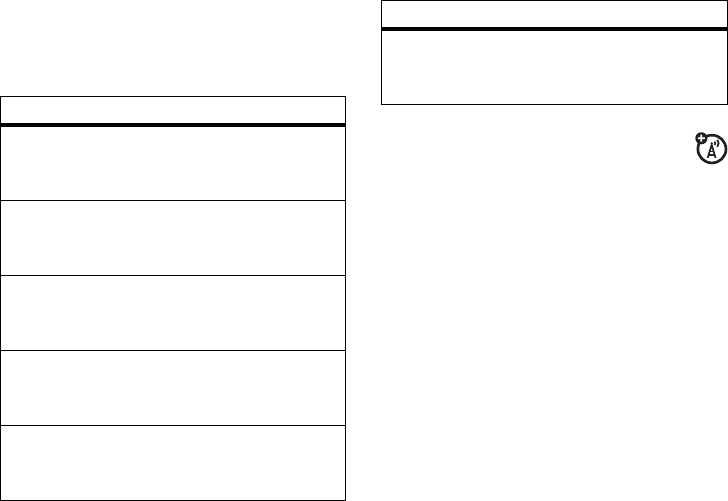
103
customize
datebook setup
Find it:
/
>
C
>
Datebook
>
/
>
Setup
You can view or change these options:
hide or show
location information
Your phone is equipped with a Location
feature for use in connection with
location-based services that may be available
in the future.
Turning Location
On
will allow the network to
detect your position using GPS technology,
making some applications and services easier
to use. Turning Location off will disable the
GPS location function for all purposes except
911, but will not hide your general location
based on the cell site serving your call. No
application or service may use your location
options
Start View:
Sets Datebook to start in day view,
week view, or month view when you
access Datebook.
Daily Begin:
Sets the beginning of your day.
This is the earliest time of day displayed in
week view, if you have a 12-hour day view.
Delete After:
Sets the amount of time
Datebook waits to delete an event after it
occurs.
Time Shift:
Lets you shift the times of all
Datebook events. This is useful if you are
traveling to a different time zone.
Alert Timeout:
Sets the amount of time a tone
continues to sound when you receive a
Datebook reminder.
Clock:
Controls whether the time and date
appear on the home screen; sets time and
date format; sets year.
options

104
customize
without your request or permission.
GPS-enhanced 911 is not available in all areas.
set your privacy options
Find it:
/
>
C
>
GPS
>
Privacy
Select from the following options:
change GPS PIN
When you receive your phone, your GPS PIN
is 0000.
To change your GPS PIN press
/
>
u
>
Security
>
Change Passwords
>
GPS PIN
. Enter the
current GPS PIN and enter the new four to
eight digit GPS PIN. Re-enter the new four- to
eight-digit GPS PIN to confirm.
option
Restricted:
No Java or similar software
applications may view the location of your
phone. However, location information may
still be available to the phone’s owner, fleet
manager, or account administrator.
Unrestricted:
All applications may view the
location of your phone, without notifying
you.
By Permission:
When an application attempts to
view the location of your phone, you will be
prompted to give permission. However,
location information may still be available to
the phone’s owner, fleet manager, or
account administrator.
option
105
customize
reorder apps menu
Java applications can be reordered to change
the order in which they appear in your phone.
Find it:
/
>
Games and Apps
to reorder apps menu
1
Press
/
>
Games and Apps.
2
Highlight
Java System
and
press
/
.
3
Select
Reorder Apps Menu.
4
Scroll to the java application you want to
move and press
K
under
Grab.
5
Scroll to the place where you want the
java application to appear and press
K
under
Insert.

106
Legal and Safety
Legal and Safety
Safety and General Information
This section contains important information on the safe and
efficient operation of your mobile device. Read this
information before using your integrated multi-service
portable radio.*
Exposure to Radio Frequency (RF) Energy
Your mobile device contains a transmitter and receiver. When it is
ON, it receives and transmits RF energy. When you communicate
with your phone, the system handling your call controls the power
level at which your phone transmits.
Your mobile device is designed to comply with local regulatory
requirements in your country concerning exposure of human beings
to RF energy.
Portable Radio Product Operation and EME
Exposure
Your Motorola radio product is designed to comply with the
following national and international standards and guidelines
regarding exposure of human beings to radio frequency
electromagnetic energy (EME):
•
United States Federal Communications Commission, Code
of Federal Regulations; 47 CFR part 2 sub-part J.
•
American National Standards Institute (ANSI) / Institute of
Electrical and Electronics Engineers (IEEE). C95. 1-1992.
•
Institute of Electrical and Electronics Engineers (IEEE).
C95. 1-2005 Edition.
*
•
International Commission on Non-Ionizing Radiation
Protection (ICNIRP) 1998.
•
Ministry of Health (Canada). Safety Code 6. Limits of
Human Exposure to Radio frequency Electromagnetic
Fields in the Frequency Range from 3 kHz to 300 GHz,
1999.
•
Australian Communications Authority Radio
communications (Electromagnetic Radiation - Human
Exposure) Standard 2003.
•
ANATEL, Brazil Regulatory Authority, Resolution 303 (July
2, 2002) “Regulation of the limitation of exposure to
* The information provided in this document supersedes the general
safety information in user’s guides published prior to May 1, 2006
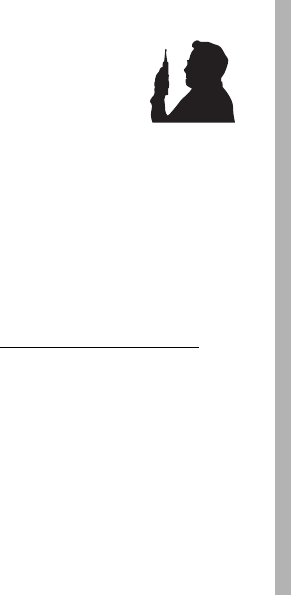
Legal and Safety
107
electrical, magnetic, and electromagnetic fields in the
radio frequency range between 9 kHz and 300 GHz.”
“Attachment to Resolution 303 from July 2, 2002."
Operational Precautions
For optimal mobile device performance, and to be sure that human
exposure to RF energy does not exceed the guidelines set forth in
the relevant standards, always follow these instructions and
precautions.
Phone Operation
When placing or receiving a phone call, hold your mobile phone as
you would a landline telephone.
Speak directly into the
microphone
.
Two-way radio operation
Your radio product has been designed and tested to comply with
national and international standards and guidelines regarding
human exposure to RF electromagnetic energy, when operated in
the two-way mode (at the face, or at the abdomen when using an
audio accessory) at usage factors of up to 50% talk/50% listen.
Transmit no more than the rated duty factor of 50% of the time. To
transmit (talk), push the PTT button. To receive calls, release the
PTT button. Transmitting 50% of the time or less, is important
because this radio generates measurable RF energy only when
transmitting (in terms of measuring for standards compliance).
When using your radio product as a traditional
two-way radio,
hold the radio product in a
vertical position with the microphone one
to two inches (2.5 to 5 cm) away from the
lips
.
If you wear the mobile device on your body,
always place the mobile device in a Motorola approved clip,
holder, holster, case or body harness. If you do not use a body-worn
accessory supplied or approved by Motorola and are not using the
mobile device in the intended use positions along side the head in
the phone mode or in front of the face in the two-way radio mode,
or if you hang your device from a lanyard around your neck, keep
the device at least 2.5 centimeters (1 inch) from your body when
transmitting.
Approved Accessories
For a list of approved Motorola accessories call 1-800-453-0920, or
visit our website at www.motorola.com/phoneaccessories.
RF Energy Interference/Compatibility
Nearly every electronic device is subject to RF energy interference
from external sources if inadequately shielded, designed or
otherwise configured for RF energy compatibility. In some
circumstances your mobile device may cause interference with
other devices.

108
Legal and Safety
Follow Instructions to Avoid Interference
Problems
Turn OFF your mobile device in any location where posted notices
instruct you to do so.
In an aircraft, turn off your mobile device whenever instructed to
do so by airline staff. If your mobile device offers an airplane mode
or similar feature, consult airline staff about using it in flight.
Implantable Medical Devices
If you have an implantable medical devices, such as a pacemaker
or defibrillator, consult your physician before using this mobile
device.
Persons with implantable medical devices should observe the
following precautions:
•
ALWAYS keep the mobile device more than 20
centimeters (8 inches) from the implantable medical
device when the phone is turned ON.
•
DO NOT carry the mobile device in the breast pocket;
•
Use the ear opposite the implantable medical device to
minimize the potential for interference.
•
Turn OFF the mobile device immediately if you have any
reason to suspect that interference is taking place.
Read and follow the directions from the manufacturer of your
implantable medical device. If you have any questions about using
your mobile device with your implantable medical device, consult
your health care provider.
Hearing Aids
Some phones may interfere with some hearing aids. In the event of
such interference, you may want to consult your hearing aid
manufacturer or physician to discuss alternatives.
Other Medical Devices and Health Care Facilities
If you use any other personal medical devices, consult your
physician or the manufacturer or your device to determine if it is
adequately shielded from RF energy. Turn off your radio product
when instructed to do so in hospitals or health care facilities that
may be using equipment that is sensitive to external RF energy.
Bluetooth
This device supports Bluetooth 2.1 with EDR including HSP, HFP,
OPP, DUN, PBAP, GAP, SDP, GAVDP, A2DP, AVRCP1.0, AVRCP1.3,
SPP, OBEX, FTP and BPP. In order for Bluetooth devices to
communicate with one another, they must utilize the same
Bluetooth profile. To determine the profiles supported by other
Motorola devices, visit www.hellomoto.com/bluetooth. For other
devices, contact their respective manufacturer.
Certain Bluetooth features including those listed may not be
supported by all compatible Bluetooth-enabled devices, and/or the
functionality of such features may be limited in certain devices, or

Legal and Safety
109
by certain wireless carriers. Contact your wireless carrier about
feature availability and functionality.
Caring for the Environment by
Recycling
This symbol on a Motorola product means the
product should not be disposed of with household
waste.
Disposal of your Mobile Device and Accessories
Please do not dispose of mobile devices or electrical accessories
(such as chargers, headsets, or batteries) with your household
waste. These items should be disposed of in accordance with the
national collection and recycling schemes operated by your local or
regional authority. Alternatively, you may return unwanted mobile
devices and electrical accessories to any Motorola Approved
Service Center in your region. Details of Motorola approved
national recycling schemes, and further information on Motorola
recycling activities can be found at:
www.motorola.com/recycling
Disposal of your Mobile Device Packaging and
User’s Guide
Product packaging and user’s guides should only be disposed of in
accordance with national collection and recycling requirements.
Please contact your regional authorities for more details.
Driving Precautions
The use of wireless phones while driving may cause distraction.
Discontinue a call if you can’t concentrate on driving.
Additionally, the use of wireless devices and their accessories may
be prohibited or restricted in certain areas. Always obey the laws
and regulations on the use of these products.
Responsible driving practices can be found in the “Smart Practices
While Driving” section (see page 122).
Operational Warnings
Obey all posted signs when using Mobile devices in public areas.
Potentially Explosive Atmospheres
Areas with potentially explosive atmospheres are often but not
always posted, and can include fueling areas such as below decks
on boats, fuel or chemical transfer or storage facilities, or areas
where the air contains chemicals or particles, such as grain, dust
or metal powders.
When you are in such area, turn off your handset, and do not
remove, install, or charge batteries unless it is a radio product type
especially qualified for use in such areas as “Intrinsically Safe” (for
example, Factory Mutual, CSA, or UL approved). In such areas,
sparks can occur and cause an explosion or fire.
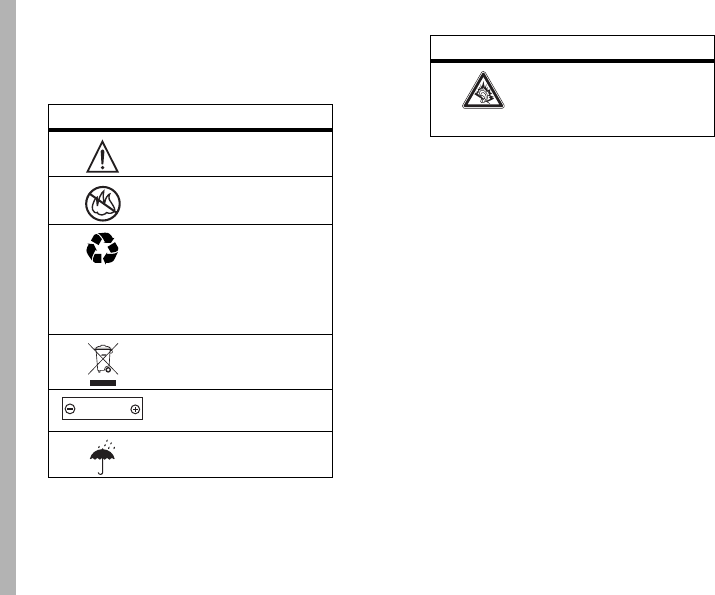
110
Legal and Safety
Symbol Key
Your battery, charger, or portable radio may contain symbols,
defined as follows:
Batteries and Chargers
Caution: Improper treatment or use of batteries may present
a danger of fire, explosion, leakage, or other hazard. For
more information, see the “Battery Use and Battery Safety”
section in this user’s guide.
Keep Your Mobile Device and Its Accessories
Away from Small Children
These products are not toys and may be hazardous to small
children. For example:
•
A choking hazard may exist for small, detachable parts.
•
Improper use could result in loud sounds, possibly causing
hearing injury.
•
Improperly handled batteries could overheat and cause a
burn.
Glass Parts
Some parts of your mobile device may be made of glass. This glass
could break if the product is dropped on a hard surface or receives
Symbol Definition
Important safety information
follows.
Do not dispose of your battery
or phone in a fire.
Your battery or phone may
require recycling in
accordance with local laws.
Contact your local regulatory
authorities for more
information.
Do not throw your battery or
phone in the trash.
Your phone contains an
internal lithium ion battery.
Do not let your battery,
charger, or phone get wet.
032374o
032376o
032375o
032378o
Li Ion BATT
Listening at full volume to
music or voice through a
headset may damage your
hearing.
Symbol Definition

Legal and Safety
111
a substantial impact. If glass breaks, do not touch or attempt to
remove. Stop using your mobile device until the glass is replaced
by a qualified service center.
Seizures/Blackouts
Some people may be susceptible to epileptic seizures or blackouts
when exposed to flashing lights, such as when playing video
games. These may occur even if a person has never had a previous
seizure or blackout.
If you have experienced seizures or blackouts, or if you have a
family history of such occurrences, please consult with your
physician before playing video games or enabling a flashing-lights
feature (if available) on your mobile device.
Discontinue use and consult a physician if any of the following
symptoms occur: convulsion, eye or muscle twitching, loss of
awareness, involuntary movements, or disorientation. It is always
a good idea to hold the screen away from your eyes, leave the
lights on in the room, take a 15-minute break every hour, and stop
use if you are very tired.
Caution About High Volume Usage
Warning:
Warning: Exposure to loud noise from any
source for extended periods of time may affect your
hearing. The louder the volume sound level, the
less time is required before your hearing could be
affected. To protect your hearing:
•
Limit the amount of time you use headsets or headphones
at high volume.
•
Avoid turning up the volume to block out noisy
surroundings.
•
Turn the volume down if you can’t hear people speaking
near you.
If you experience hearing discomfort, including the sensation of
pressure or fullness in your ears, ringing in your ears, or muffled
speech, you should stop listening to the device through your
headset or headphones and have your hearing checked.
For more information about hearing, see our Web site at
www.motorola.com/hearingsafety
(in English only).
Repetitive Motion
When you repetitively perform actions such as pressing keys or
entering finger-written characters, you may experience occasional
discomfort in your hands, arms, shoulders, neck, or other parts of
your body. If you continue to have discomfort during or after such
use, stop use and see a physician.
Open Source Software Information
For instructions on how to obtain a copy of any source code being
made publicly available by Motorola related to software used in
this Motorola mobile device you may send your request in writing
to the address below. Please make sure that the request includes
the model number and the software version number.

112
Legal and Safety
MOTOROLA, INC.
OSS Management
600 North US Hwy 45
Libertyville, IL 60048
USA.
The Motorola website opensource.motorola.com also contains
information regarding Motorola’s use of open source.
Motorola has created the opensource.motorola.com to serve as a
portal for interaction with the software community-at-large.
To view additional information regarding licenses,
acknowledgments and required copyright notices for open source
packages used in this Motorola mobile device, please select
Main Menu > Java Apps > OpenSourceNotices.
In addition,
this Motorola device may include self-contained applications that
present supplemental notices for open source packages used in
those applications.
Service and Repairs
If you have questions or need assistance, we’re here to help.
Go to
www.motorola.com/support
, where you can select from
a number of customer care options. You can also contact the
Motorola Customer Support Center at 1 (800) 453-0920 (United
States), 1 (877) 483-2840 (TTY, TDD United States for hearing
impaired).
Export Law Assurances
This product is controlled under the export regulations of the
United States of America and Canada. The Governments of the
United States of America and Canada may restrict the exportation
or re-exportation of this product to certain destinations. For further
information contact the U.S. Department of Commerce or the
Canadian Department of Foreign Affairs and International Trade.
Battery Use and Safety
• Motorola recommends you always use
Motorola-branded batteries and chargers.
The
warranty does not cover damage caused by non-Motorola
batteries and/or chargers.
Caution:
Use of an unqualified battery or charger may
present a risk of fire, explosion, leakage, or other hazard.
Improper battery use, or use of a damaged battery, may
result in a fire, explosion, or other hazard.
•
Battery usage by children should be supervised.
• Important
: Motorola mobile devices are designed to work
best with qualified batteries. If you see a message on your
display such as
Invalid Battery
or
Unable to Charge
, take the
following steps:
•
Remove the battery and inspect it to confirm it bears a
Motorola “Original Equipment” hologram;

Legal and Safety
113
•
If there is no hologram, the battery is not a qualified
battery;
•
If there is a hologram, replace the battery and retry
charging it;
•
If the message remains, contact a Motorola Authorized
Service Center.
•
When storing your battery, keep it in a cool, dry place.
•
It is normal over time for battery life to decrease, and for
the battery to exhibit shorter runtime between charges or
require more frequent or longer charging times.
Important: Handle and store batteries properly to avoid
injury or damage.
Most battery issues arise from improper
handling of batteries, and particularly from the continued use of
damaged batteries.
DON’Ts
• Don’t disassemble, crush, puncture, shred, or
otherwise attempt to change the form of your
battery.
• Don’t let the phone or battery come in contact with
water.
Water can get into the phone’s circuits, leading to
corrosion. If the phone and/or battery get wet, have them
checked by your carrier or contact Motorola, even if they
appear to be working properly.
• Don’t allow the battery to touch metal objects.
If
metal objects, such as jewelry, stay in prolonged contact
with the battery contact points, the battery could become
very hot.
• Don’t place your battery near a heat source.
Excessive heat can damage the phone or the battery. High
temperatures can cause the battery to swell, leak, or
malfunction. Therefore:
•
Do
not
dry a wet or damp battery with an appliance or
heat source, such as a hair dryer or microwave oven.
•
Avoid leaving your phone in your car in high temperatures.
DOs
• Do avoid dropping the battery or phone.
Dropping
these items, especially on a hard surface, can potentially
cause damage.
• Do contact your service provider or Motorola if your
phone or battery has been damaged from dropping
or high temperatures.
Important: Use Motorola Original products for quality
assurance and safeguards.
To aid consumers in identifying
authentic Motorola batteries from non-original or counterfeit
batteries (that may not have adequate safety protection), Motorola
provides holograms on its batteries. Consumers should confirm
that any battery they purchase has a “Motorola Original”
hologram.
Motorola recommends you always use Motorola-branded
batteries and chargers.
Motorola mobile devices are designed
to work with Motorola batteries. If you see a message on your

114
Legal and Safety
display such as
Invalid Battery
or
Unable to Charge
, take the following
steps:
•
Remove the battery and inspect it to confirm that it has a
“Motorola Original” hologram;
•
If there is no hologram, the battery is not a Motorola
battery;
•
If there is a hologram, replace the battery and retry
charging it;
•
If the message remains, contact a Motorola authorized
service center.
Important:
Motorola’s warranty does not cover damage to the
phone caused by non-Motorola batteries and/or chargers.
Warning:
Use of a non-Motorola battery or charger may present a
risk of fire, explosion, leakage, or other hazard.
Proper and safe battery disposal and recycling:
Proper
battery disposal is not only important for safety, it benefits the
environment. Consumers may recycle their used batteries in many
retail or service provider locations. Additional information on
proper disposal and recycling may be found on the Web:
• www.motorola.com/recycling
• www.rbrc.org/call2recycle/
(in English only)
Disposal:
Promptly dispose of used batteries in accordance with
local regulations. Contact your local recycling center or national
recycling organizations for more information on how to dispose of
batteries.
Warning:
Never dispose of batteries in a fire because they may
explode.
Battery Charging
Notes for charging your phone’s battery:
•
When charging your battery, keep it near room
temperature. Never expose batteries to temperatures
below 0°C (32°F) or above 45°C (113°F) when charging.
•
New batteries are not fully charged.
•
New batteries or batteries stored for a long time may take
more time to charge.
•
Motorola batteries and charging systems have circuitry
that protects the battery from damage from overcharging.
Specific Absorption Rate
Your model wireless phone meets the governmental
requirements for exposure to radio waves.
Your mobile device is a radio transmitter and receiver. It is
designed and manufactured to not exceed limits for exposure to
radio frequency (RF) energy set by the Federal Communications
Commission (FCC) of the U.S. Government and by the Canadian
regulatory authorities. These limits are part of comprehensive
guidelines and establish permitted levels of RF energy for the
general population. The guidelines are based on standards that

Legal and Safety
115
were developed by independent scientific organizations through
periodic and thorough evaluation of scientific studies. The
standards include a substantial safety margin designed for the
safety of all persons, regardless of age or health, and to account
for any variations in measurements.
The exposure standard for mobile devices employs a unit of
measurement known as the Specific Absorption Rate (SAR). The
SAR limit set by the FCC and by the Canadian regulatory
authorities is 1.6 watts per kilogram (W/kg), averaged over one
gram of tissue. Tests for SAR are conducted using procedures
accepted by the FCC and by Industry Canada with the mobile
device transmitting at its highest certified power level in all tested
frequencies. Although the SAR is determined at the highest
certified power level, the actual SAR level of the mobile device
while operating can be below the maximum value. This is because
the mobile device is designed to operate at multiple power levels
so as to use only the power required to reach the network. In
general, the closer you are to a wireless base station, the lower
the power output.
Before a mobile device is available for sale to the public in the U.S.
and Canada, it must be tested and certified to the FCC and Industry
Canada that it does not exceed the limit established by each
government for safe exposure. The tests are performed in
positions and locations (e.g., at the ear and worn on the body)
submitted to the FCC and available for review by Industry Canada.
The highest SAR value for this mobile device when tested for use
at the ear is 0.59 W/kg, and when worn on the body, as described
in this guide, is 0.86 W/kg. Body-worn measurements can differ,
depending upon available accessories and regulatory
requirements. The SAR information includes the Motorola testing
protocol, assessment procedure, and measurement uncertainty
range for this product.
While there may be differences between the SAR levels of various
mobile devices and at various positions, they meet the
governmental requirements for safe exposure. Please note that
improvements to this product model could cause differences in the
SAR value for later products; in all cases, products are designed to
be within the guidelines.
Additional information on SAR can be found on the Cellular
Telecommunications & Internet Association (CTIA) Web site:
http://www.phonefacts.net
or the Canadian Wireless Telecommunications Association (CWTA)
Web site:
http://www.cwta.ca
AGPS and Emergency Calls
When you make an emergency call, your mobile device can use
Assisted Global Positioning System (AGPS) satellite signals to tell
the emergency response center your approximate location.
The AGPS feature has limitations, so always tell the emergency
response center your best knowledge of your location. Remain on
the phone for as long as the emergency response center instructs
you.
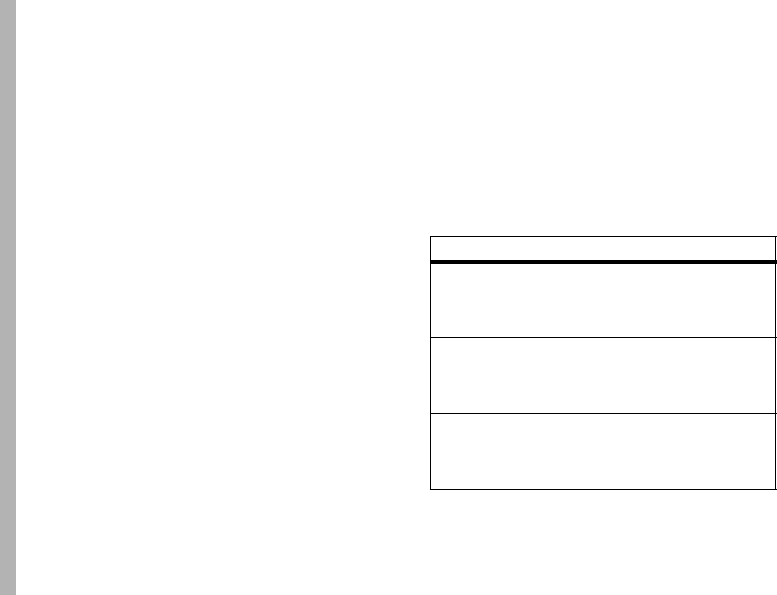
116
Legal and Safety
AGPS
might not work
for emergency calls, if your local
emergency response center does not process AGPS location
information. For details, contact your local authorities.
If your mobile device cannot find strong AGPS satellite signals, the
location of the nearest cell tower in contact with your mobile
device is automatically provided to the emergency response
center.
AGPS Performance Tips
•
Go outside and away from underground locations, covered
vehicles, structures with metal or concrete roofs, tall
buildings, and foliage. Indoor performance might improve
if you move closer to windows, but some window sun
shielding films can block satellite signals.
•
Move away from radios, entertainment equipment, and
other electronic devices that might interfere with or block
AGPS satellite signals.
AGPS uses satellites controlled by the U.S. government and
subject to changes implemented in accordance with the
Department of Defense AGPS user policy and the Federal Radio
Navigation Plan. These changes might affect AGPS performance.
Limited Warranty Motorola
Communications Products
(International)
What Does this Warranty Cover?
MOTOROLA warrants the MOTOROLA manufactured iDEN
Communication Products listed below (“Product”) against defects
in material and workmanship under normal use and service for a
period of time from the date of purchase as scheduled below:
Products Covered Length of Coverage
iDEN Subscriber
Digital Mobile and
Portable Units
One (1) year
from the date of
purchase by the first consumer
purchaser of the product unless
otherwise provided for below.
Product Accessories
(manufactured by or
under license from
MOTOROLA).
One (1) year
from the date of
purchase by the first consumer
purchaser of the product unless
otherwise provided for below.
Batteries. One (1) year
from the date of
purchase by the first consumer
purchaser of the product unless
otherwise provided for below.

Legal and Safety
117
Rechargeable Batteries will be replaced during the applicable
warranty period if:
•
the battery capacity falls below 80% of rated capacity, or
•
the battery develops leakage.
MOTOROLA, at its option, will at no charge either repair the
Product (with new or reconditioned parts), replace it (with a new or
reconditioned Product), or refund the purchase price of the Product
during the warranty period provided it is returned in accordance
with the terms of this warranty. Replaced parts or boards are
warranted for the balance of the original applicable warranty
period. All replaced parts of Product shall become the property of
MOTOROLA.
This express limited warranty is extended by MOTOROLA to the
original end user purchaser only and is not assignable or
transferable to any other party. This is the complete warranty for
the Product manufactured by MOTOROLA. MOTOROLA assumes
no obligations or liability for additions or modifications to this
warranty unless made in writing and signed by an officer of
MOTOROLA. Unless made in a separate agreement between
MOTOROLA and the original end user purchaser, MOTOROLA does
not warrant the installation, maintenance or service of the Product.
MOTOROLA cannot be responsible in any way for any ancillary
equipment not furnished by MOTOROLA which is attached to or
used in connection with the Product, or for operation of the Product
with any ancillary equipment, and all such equipment if expressly
excluded from this warranty. Because each system which may use
the Product is unique, MOTOROLA disclaims liability for range,
coverage, or operation of the system as a whole, or any portion of
the system not produced by MOTOROLA, under this warranty.
General Provisions:
This warranty sets forth the full extent of MOTOROLA’S
responsibilities regarding the Product, Repair, replacement or
refund of the purchase price, at MOTOROLA’S options, is the
exclusive remedy. THIS WARRANTY IS GIVEN IN LIEU OF ALL
OTHER EXPRESS WARRANTIES. IMPLIED WARRANTIES,
INLCUDING WITHOUT LIMITATION, IMPLIED WARRANTIES OF
MERCHANTABILITY AND FITNESS FOR A PARTICULAR PURPOSE,
ARE LIMITED TO THE DURATION OF THIS LIMITED WARRANTY TO
THE FULL EXTENT SUCH MAY BE DISCLAIMED BY LAW. IN NO
EVENT SHALL MOTOROLA BE LIABLE FOR DAMAGES IN EXCESS
OF THE PURCHASE PRICE OF THE PRODUCT, FOR ANY LOSS OF
USE, LOSS OF TIME, INCONVENIENCE, COMMERCIAL LOSS, LOST
PROFITS OR SAVINGS OR OTHER INCIDENTAL, SPECIAL OR
CONSEQUENTIAL DAMAGES ARISING OUT OF THE USE OR
INABILITY TO USE SUCH PRODUCT, TO THE FULL EXTENT SUCH
MAY BE DISCLAIMED BY LAW.
How to Get Warranty Service:
You must provide proof of purchase (bearing the date of purchase
and Product item serial number) in order to receive warranty
service and, also, deliver or send the Product item, transportation
and insurance prepaid, to an authorized warranty service location.
Warranty service will be provided by MOTOROLA through one of
its authorized warranty service locations. If you first contact the

118
Legal and Safety
company which sold you the Product (e.g., dealer or
communication service provider), it can facilitate your obtaining
warranty service.
What This Warranty Does Not Cover:
•
Defects or damage resulting from use of the Product in
other than its normal and customary manner.
•
Defects or damage from misuse, accident, water, or
neglect.
•
Defects or damage from improper testing, operation,
maintenance, installation, alteration, modification, or
adjustment.
•
Breakage or damage to antennas unless caused directly by
defects in material workmanship.
•
A Product subjected to unauthorized Product
modifications, disassembles or repairs (including, without
limitation, the audition to the Product of non-MOTOROLA
supplied equipment).
•
Product which has had the serial number removed or made
illegible.
•
Rechargeable batteries if:
Any of the seals on the battery enclosure of cells are
broken or show evidence of tampering.
The damage or defect is caused by charging or using the
battery in equipment or service other than the Product for
which it is specified.
•
Freight costs to the repair depot.
•
A Product which, due to illegal or unauthorized alteration
of the software/firmware in the Product, does not function
in accordance with MOTOROLA’S published specifications
or the local type acceptance labeling in effect for the
Product at the time the Product was initially distributed
from MOTOROLA.
•
Scratches or other cosmetic damage to Product surfaces
that does not effect the operation of the Product.
•
Normal and customary wear and tear.
•
Exclusion for defects or damage arising from use of the
products in connection with non-MOTOROLA equipment.
Patent and Software Provisions:
MOTOROLA will defend, at its own expense, any suit brought
against the end user purchaser to the extent that it is based on a
claim that the Product or parts infringe a patent, and Motorola will
pay those costs and damages finally awarded against the end user
purchaser in any such suit which are attributable to any such
claim, but such defense and payments are conditioned on the
following:
•
That MOTOROLA will be notified promptly in writing by
such purchaser of any notice of such claim;
•
That MOTOROLA will have sole control of the defense of
such suit and all negotiations for its settlement or
compromise; and

Legal and Safety
119
•
Should the Product or parts become, or in MOTOROLA’S
opinion be likely to become, the subject of a claim of
infringement of a patent, that such purchaser will permit
MOTOROLA, at its option and expense, either to procure
for such purchaser the right to continue using the Product
or parts or to replace or modify the same so that it
becomes non infringing or to grant such purchaser a credit
for the Product or parts as depreciated and accept its
return. The depreciation will be an equal amount per year
over the lifetime of the Product or parts as established by
MOTOROLA.
MOTOROLA will have no liability with respect to any claim of
patent infringement which is based upon the combination of the
Product or parts furnished hereunder with software, apparatus or
devices not furnished by MOTOROLA, nor will MOTOROLA have
any liability for the use of ancillary equipment or software not
furnished by MOTOROLA which is attached to or sued in
connection with the Product or any parts thereof. In no event shall
MOTOROLA be liable for any incidental, special or consequential
damages arising from any claim of patent infringement or alleged
infringement.
Laws in the United States and other countries preserve for
MOTOROLA certain exclusive rights for copyrighted MOTOROLA
software, such as the exclusive rights to reproduce in copies and
distribute copies of such MOTOROLA software. MOTOROLA
software may be used in only the Product in which the software
was originally embodied and such software in such Product may
not be replaced, copied, distributed, modified in any way, or used
to produce any derivative thereof. No other use including, without
limitation, alteration, modification, reproduction, distribution, or
reverse engineering of such MOTOROLA software or exercise or
rights in such MOTOROLA software is permitted. No license is
granted by implication, estoppel or otherwise under MOTOROLA
patent rights or copyrights.
Hearing Aid Compatibility With Mobile
Phones
Some Motorola phones are measured for compatibility with
hearing aids. If the box for your particular model has “Rated for
Hearing Aids” printed on it, the following explanation applies.
When some mobile phones are used near some hearing devices
(hearing aids and cochlear implants), users may detect a buzzing,
humming, or whining noise. Some hearing devices are more
immune than others to this interference noise, and phones also
vary in the amount of interference they generate.
The wireless telephone industry has developed ratings for some of
their mobile phones, to assist hearing device users in finding
phones that may be compatible with their hearing devices. Not all
phones have been rated. Phones that are rated have the rating on
their box or a label on the box.
The ratings are not guarantees. Results will vary depending on the
user’s hearing device and hearing loss. If your hearing device
happens to be vulnerable to interference, you may not be able to
use a rated phone successfully. Trying out the phone with your

120
Legal and Safety
hearing device is the best way to evaluate it for your personal
needs.
M-Ratings:
Phones rated M3 or M4 meet FCC requirements and
are likely to generate less interference to hearing devices than
phones that are not labeled. M4 is the better/higher of the two
ratings.
T-Ratings:
Phones rated T3 or T4 meet FCC requirements and are
likely to be more usable with a hearing device’s telecoil (“T
Switch” or “Telephone Switch”) than unrated phones. T4 is the
better/higher of the two ratings. (Note that not all hearing devices
have telecoils in them.)
Hearing devices may also be measured for immunity to this type of
interference. Your hearing device manufacturer or hearing health
professional may help you find results for your hearing device. The
more immune your hearing aid is, the less likely you are to
experience interference noise from mobile phones.
Information From the World Health
Organization
Present scientific information does not indicate the need for any
special precautions for the use of mobile phones. If you are
concerned, you may want to limit your own or your children’s RF
exposure by limiting the length of calls or by using hands-free
devices to keep mobile phones away from your head and body.
Source: WHO Fact Sheet 193
Further information:
http://www.who.int./peh-emf
.
Product Registration
Online Product Registration:
www.motorola.com/us/productregistration
Product registration is an important step toward enjoying your new
Motorola product. Registering permits us to contact you for
product or software updates and allows you to subscribe to
updates on new products or special promotions. Registration is not
required for warranty coverage.
Please retain your original dated sales receipt for your records. For
warranty service of your Motorola Personal Communications
Product you will need to provide a copy of your dated sales receipt
to confirm warranty status.
Thank you for choosing a Motorola product.
Wireless: The New Recyclable
Your wireless phone can be recycled. Recycling your phone
reduces the amount of waste disposed in landfills and allows
recycled materials to be incorporated into new products.
The Cellular Telecommunications Industry Association (CTIA) and
its members encourage consumers to recycle their phones and
have taken steps to promote the collection and environmentally
sound recycling of end-of-life devices.

Legal and Safety
121
As a phone user, you have an important role in ensuring that this
device is recycled properly. When it comes time to give this phone
up or trade it in for a new one, please remember that the phone,
the charger, and many of its accessories can be recycled. It's easy.
To learn more about CTIA's Recycling Program for Used Wireless
Devices, please visit us at:
http://recycling.motorola.young-america.com/ index.html
California Perchlorate Label
Some mobile phones use an internal, permanent backup battery on
the printed circuit board that may contain very small amounts of
perchlorate. In such cases, California law requires the following
label:
Perchlorate Material - special handling may apply. See
www.dtsc.ca.gov/hazardouswaste/perchlorate
.
There is no special handling required by consumers.
Patent and Trademark Information
MOTOROLA, the Stylized M Logo and all other trademarks
indicated as such herein are trademarks of Motorola, Inc. ® Reg.
U.S. Pat. & Tm. Off. © 2009 Motorola, Inc. All rights reserved.
Microsoft and Microsoft Internet Explorer are registered
trademarks of Microsoft Corporation.
T9 is a trademark owned by Tegic Communications.
T9
®
Text Input Patent and Trademark Information.
This product is covered by U.S. Pat. 5,818,437, U.S. Pat. 5,953,541,
U.S. Pat. 6,011,554 and other patents pending.
Java and all other Java-based marks are trademarks or registered
trademarks of Sun Microsystems, Inc. in the U.S. and other
countries.
All other product names or services mentioned in this manual are
the property of their respective trademark owners.
Software Copyright Notice
Motorola products may include copyrighted Motorola and third
party software stored in semiconductor memories or other media.
Laws in the United States and other countries preserve for
Motorola and third party software providers certain exclusive
rights for copyrighted software, such as the exclusive rights to
distribute or reproduce the copyrighted software. Accordingly, any
copyrighted software contained in the Motorola products may not
be modified, reverse-engineered, distributed, or reproduced in any
manner to the extent allowed by law. Furthermore, the purchase of
Motorola products shall not be deemed to grant either directly or
by implication, estoppel, or otherwise, any license under the
copyrights, patents, or patent applications of Motorola or any third
party software provider, except for the normal, non-exclusive,
royalty-free license to use that arises by operation of law in the
sale of a product.

122
Legal and Safety
Privacy and Data Security
Motorola understands that privacy and data security are important
to everyone. Because some features of your mobile device may
affect your privacy or data security, please follow these
recommendations to enhance protection of your information:
• Monitor access—
Keep your mobile device with you and
do not leave it where others may have unmonitored
access. Lock your device’s keypad where this feature is
available.
• Keep software up to date—
If Motorola or a
software/application vendor releases a patch or software
fix for your mobile device that updates the device’s
security, install it as soon as possible.
• Erase before recycling—
Delete personal information
or data from your mobile device prior to disposing of it or
turning it in for recycling. For instructions on how to delete
all personal information from your device, please contact
your local service provider.
• Understanding AGPS—
To provide location information
for emergency calls, certain Motorola mobile devices
incorporate Assisted Global Positioning System (AGPS)
technology. AGPS technology also can be used in
non-emergency applications to track and monitor a user’s
location—for example, to provide driving directions. Users
who prefer not to permit such tracking and monitoring
should avoid using such applications.
If you have further questions regarding how the use of your mobile
device may impact your privacy or data security, please contact
Motorola at
privacy@motorola.com
, or contact your service
provider.
Smart Practices While Driving
Drive Safe, Call Smart
SM
Check the laws and regulations on the use of phones and
their accessories in the areas where you drive. Always
obey them. The use of these devices may be prohibited or
restricted in certain areas—for example handsfree use
only. Go to www.motorola.com/callsmart (in English only)
for more information.
Your mobile device lets you communicate by voice and
data—almost anywhere, anytime, wherever wireless service is
available and safe conditions allow. When driving a car, driving is
your first responsibility. If you choose to use your phone while
driving, remember the following tips:
• Get to know your Motorola mobile device and its
features such as speed dial and redial.
If available,
these features help you to place your call without taking
your attention off the road.
• When available, use a handsfree
device.
If possible, add an additional
layer of convenience to your phone with

Legal and Safety
123
one of the many Motorola Original handsfree accessories
available today.
• Position your mobile device within easy reach.
Be
able to access your phone without removing your eyes
from the road. If you receive an incoming call at an
inconvenient time, if possible, let your voice mail answer
it for you.
• Let the person you are speaking with know you are
driving; if necessary, suspend the call in heavy
traffic or hazardous weather conditions.
Rain, sleet,
snow, ice, and even heavy traffic can be hazardous.
• Do not take notes or look up phone numbers while
driving.
Jotting down a “to do” list or going through your
address book takes attention away from your primary
responsibility, driving safely.
• Dial sensibly and assess the traffic; if possible,
place calls when your car is not moving or before
pulling into traffic.
If you must make a call while
moving, dial only a few numbers, check the road and your
mirrors, then continue.
• Do not engage in stressful or emotional
conversations that may be distracting.
Make people
you are talking with aware you are driving and suspend
conversations that can divert your attention away from the
road.
• Use your mobile device to call for help.
Dial 911 or
other local emergency number in the case of fire, traffic
accident, or medical emergencies (wherever wireless
phone service is available).
• Use your mobile device to help others in
emergencies.
If you see an auto accident, crime in
progress, or other serious emergency where lives are in
danger, call 911 or other local emergency number
(wherever wireless phone service is available), as you
would want others to do for you.
• Call roadside assistance or a special
non-emergency wireless assistance number when
necessary.
If you see a broken-down vehicle posing no
serious hazard, a broken traffic signal, a minor traffic
accident where no one appears injured, or a vehicle you
know to be stolen, call roadside assistance or other
special non-emergency wireless number (wherever
wireless phone service is available).

124
index
index
A
accessories 9
active phone line 40
advanced calling 16
3-way calls 16
call waiting 16
alert
set 44, 100
turn off 44, 83
answer a call 16
auto replies 29
B
backlight 101
battery charging 14
battery charging indicators
14
battery installation 12
Bluetooth 79
connect 79
send information 81
setting your phone 79
turning on or off 79
C
call
answer 16
any key answer 17
end 16
make 16
call completion 19
call forward 85
caller ID 84
calls
SDG, see SDG calls
camcorder 50
camera 50, 61, 64
media center 65, 67
self-timer 65
carousel menu 40
center key 45
center select key 9
contacts 102
edit/delete 20
set picture ID 20
set ringer ID 20
125
index
D
datebook 102
create events 102
receive events via PTT
102
setup 103
view reminders 102
dial a phone number 16
dialed calls 83
direct launch 98
display 39
drafts
see also text messages,
drafts
25
E
earpiece volume 44
emergency number 86
end a call 16
end key 16
F
frequently asked questions
service and repairs 112
G
GPS enabled
emergency calls 86
GPS PIN
enable GPS PIN 48
GPS, see GPS enabled
H
handsfree speaker 45
hearing aid 46
Hearing Aid Compatibility
119
home screen 39
I
images
editing 62
menu 62
my images 62
slideshow 62
viewing 63
international calls 87
L
lock keypad 48
M
main menu 40
make a call 16
media center 49, 50
memory card 10
insert 11
remove 11
message center
text messages 26
126
index
message indicator 40
messaging 21
modem
using your handset as a
38
MOTOtalk
calls, ending 97
channels 93
channels, setting 94
code calls, making 94
code calls, receiving 95
codes 93
codes, setting 94
direct launch 98
emergency calls 97
private MOTOtalk calls 96
private only setting 96
receiving all calls 95
setup options 98
state tone 99
switching to 93
switching to network
mode 93
talk range 93
multimedia 49
my images 50, 62
my music 50, 54
my videos 50, 63
N
navigation key 9, 45
O
one touch PTT 76
optional accessory 9
optional feature 9
P
packet data 40
phone number 21
power key 15
private calls
answer 18
call alerts 17
make 17
receive a call alert 18
PT Manager 78
PTX features 69
R
radio frequency 106
received calls 83
recent calls 83
recycling 120
redial 84
reorder apps menu 105
ring style indicator 40
ring style, setting 44
ring tones 50
off 100
setting 100
vibrate 100, 101
ringer volume 44
127
index
S
safety
radio frequency 106
RF energy interference
107
safety information 106
safety tips 122
SDG calls
lists, adding numbers 89
lists, creating 88
lists, deleting 89
lists, remove members 89
lists, save entries 78
make call 90
starting 90
security 48
selective dynamic group
calls, see SDG calls
send key 16
signal strength indicator 39
SIM card 10
change SIM PIN 48
enable SIM PIN 48
soft keys 39
speaker 40
speed dial 87
state tone 99
store your number 21
T
text entry 41
alpha method 43
word method 42
text messages 21, 38
creating 21
deleting 32
drafts 25
memory 33
message center 26
receiving 26
resend messages 32
sending 21
sent messages 32
V
videos
my videos 63
viewing 63
voice names 85
voicemail 87
message indicator 88
receiving 88
setting up 87
voicerecord 50
volume 44
W
wallpaper 101
WHO information 120
Y
your phone number 21
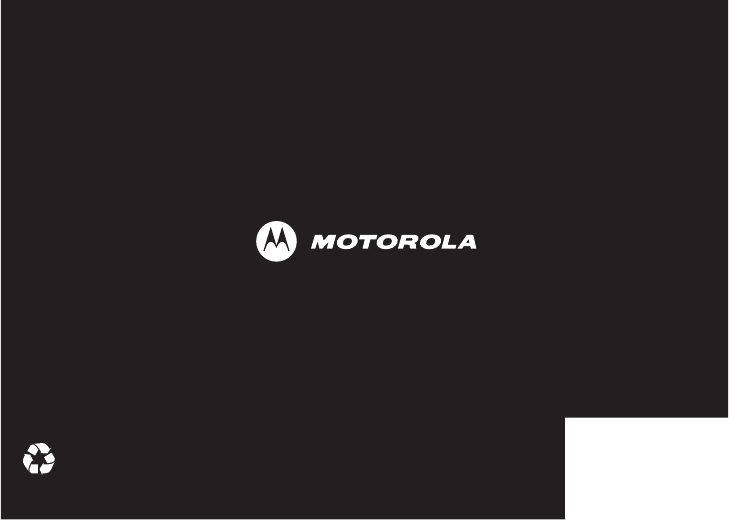
www.motorola.com
NNTN7797A
@NNTN7797A@
xxxxxxxx xx xx SEPT/09
Printed in USA